Kristine Hughes's Blog, page 79
March 2, 2015
MR. TURNER
Victoria, reporting that for months we've heard praises for the film Mr. Turner...but frankly, I wondered if I'd ever get the chance to see it. The film appeared in some American theatres in mid-December for a brief time and then disappeared. I guess I wasn't paying attention then, and I despaired of getting second chance.
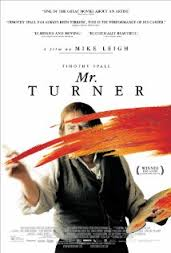 Poster for the film Mr. Turner
Poster for the film Mr. Turner
But, wonder of wonders, it reappeared at local cinemas; Kristine and I made a date to see the film on a sunny Sunday afternoon in Ft Myers FL.
To watch the official trailer, click here.
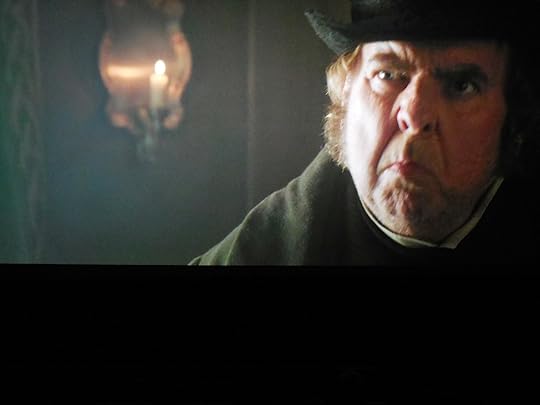 Timothy Spall is brilliant in the title role; he has already won many Best Actor Awards, including at the Cannes Film Festival, and he deserves even more.
Timothy Spall is brilliant in the title role; he has already won many Best Actor Awards, including at the Cannes Film Festival, and he deserves even more.
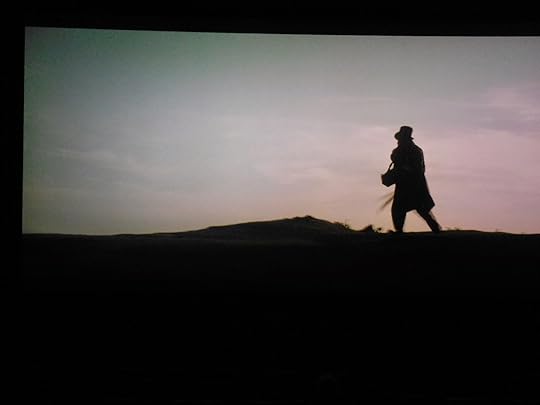 Though the quality of this snapshot hardly does it justice, the cinematography was incredible.
Though the quality of this snapshot hardly does it justice, the cinematography was incredible.
Director Mike Leigh apparently was passed over for nominations for BAFTAs and Oscars, though he too has won several awards and deserves more. But Mr. Turner is not your average blockbuster popular film, aimed at massive audiences, though I hope it gets widespread distribution anyway.
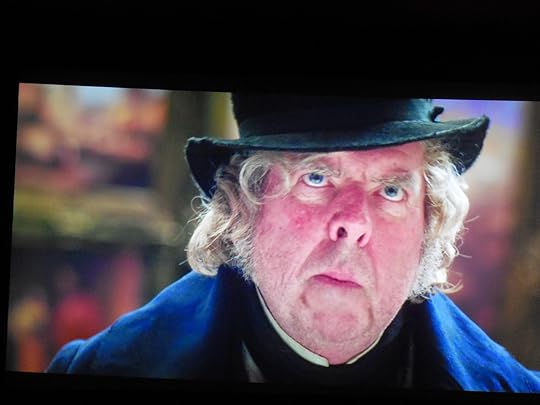
The film follows Joseph Mallord William Turner ((1775 - 1851) in later life, when he had already earned a distinguished reputation, particularly for his landscapes and nautical scenes. He is a curmudgeonly character, abrupt and eccentric, unkind to the mother of his children, to those daughters (which he apparently did not acknowledge as his), and was abusive to his housemaid, Nevertheless he was a magnificent artist, and it is great film.
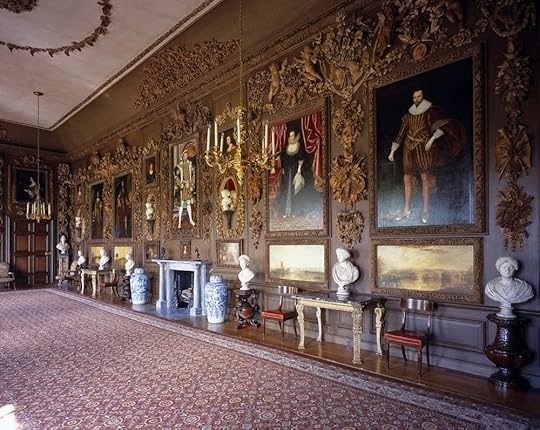 Petworth House, West Sussex
Petworth House, West Sussex
Turner visited almost annually at Petworth House, home of the 3rd Earl of Egremont. He painted both inside the house and on the grounds.Some scenes of the movies are set at Petworth and you can read about the filming there by clicking here.
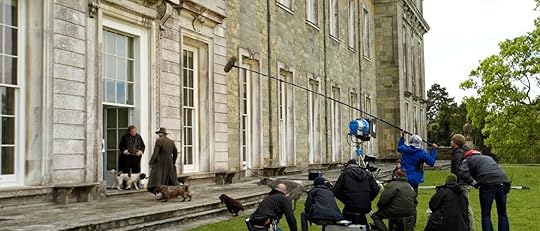 Filming at Petworth NT
Filming at Petworth NT
Petworth is now operated by the National Trust. A magnificent collection of paintings is on view there, as well as the fascinating interiors, even the kitchens, and the grounds too. For more information, click here. The NT has mounted a special exhibition related to the film, on display until March 11, 2015, at Petworth.
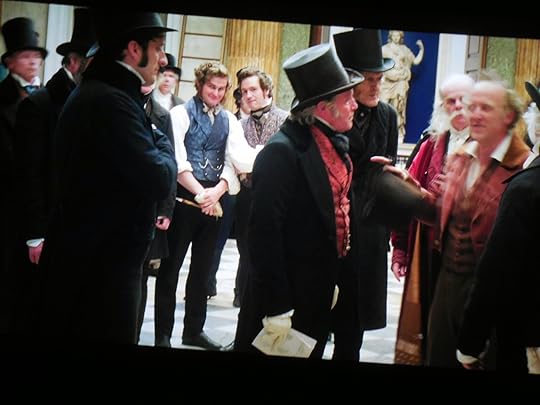 Scenes set at the Royal Academy annual exhibitions were especially interesting, with their portrayals of so many of our favorite artists, including John Constable and Benjamin Haydon, below, played by Martin Savage. Relationships among the artists were often prickly and one can hardly be surprised that the competitive spirit reigned.
Scenes set at the Royal Academy annual exhibitions were especially interesting, with their portrayals of so many of our favorite artists, including John Constable and Benjamin Haydon, below, played by Martin Savage. Relationships among the artists were often prickly and one can hardly be surprised that the competitive spirit reigned.
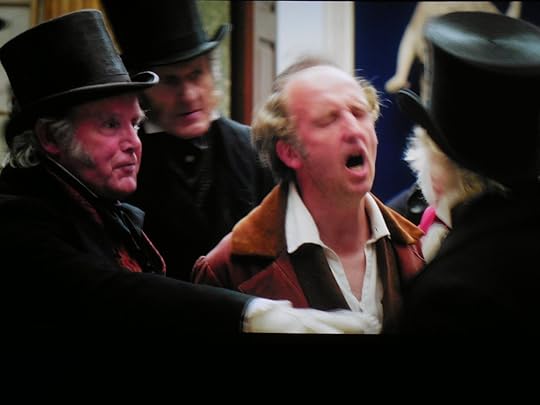
More comfortable was the growth of Turner's relationship with Mrs. Booth, a widow from Margate, Kent, where he want to paint the sea. Mrs. Booth is sympathetically portrayed by actress Marion Bailey. He bought her a house in Chelsea where they lived together for many years.
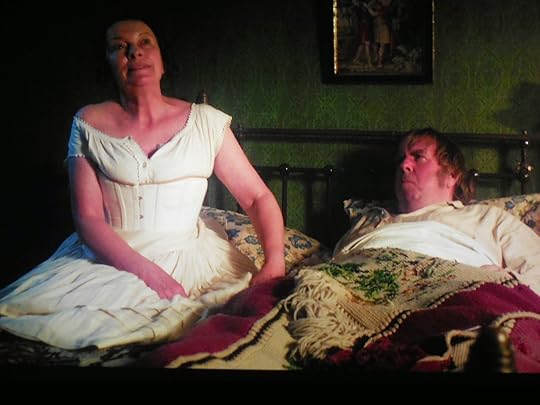
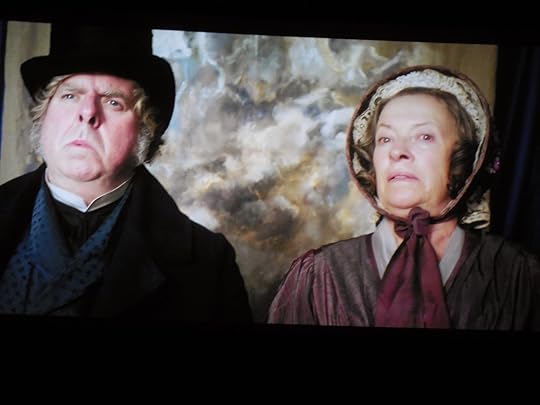
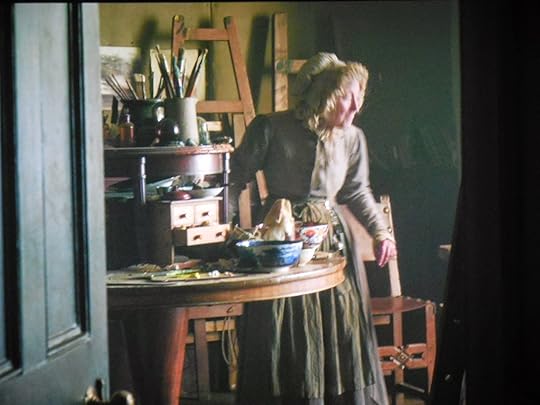 Dorothy Atkinson as Hannah Danby, Turner's housemaid
Dorothy Atkinson as Hannah Danby, Turner's housemaid
Atkinson gives an amazing performance as Hannah, who grows ever more pitiable as she endures his moods, his mistreatment, her own growing strangeness and affliction. I was surprised when looking at the cast listing to find that Hannah Danby was the niece of Sarah Danby, the woman who claimed to have had two daughters with Turner, though they were never married.
Another performance, hardly more than a cameo, interested me because I've seen Sylvestra Le Touzel in several films and on the London stage.
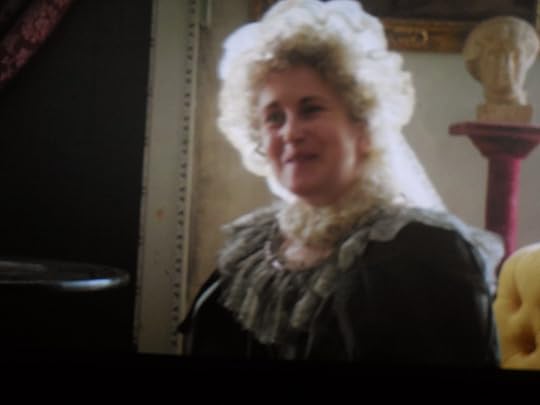 Sylvestra Le Touzel as John Ruskin's mother
Sylvestra Le Touzel as John Ruskin's mother
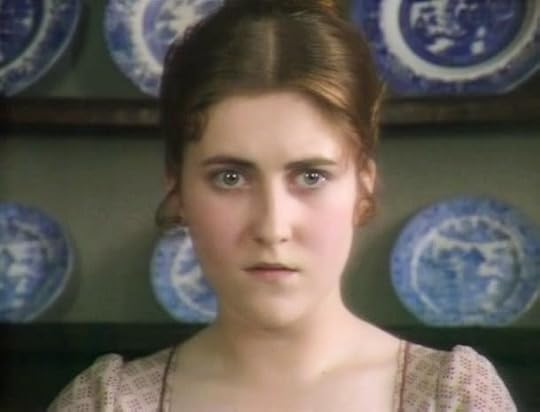 Le Touzel as Fanny Price in the 1983 BBC production of Mansfield Park
Le Touzel as Fanny Price in the 1983 BBC production of Mansfield Park
Mentioning Ruskin brings up two aspects of the film that I didn't like. John Ruskin (1819-1900) was a great authority on Victorian Art, a painter himself, and, I believe a worthy critic who admired Turner's work. But in this film version he is about as obnoxious a dandy as possible. Too see a critique from The Guardian on the subject, click here.
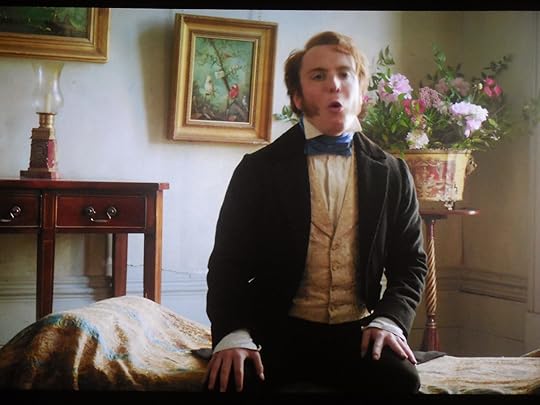 Joshua McGuire as John Ruskin
Joshua McGuire as John Ruskin
The second thing I disliked was the cliched representation of Queen Victoria and Prince Albert as disliking Turner's work and denigrating it as the product of failing eyesight. I know they liked the work of Landseer, Leighton, and Winterhalter, but I wonder if the opinions expressed in the film are quite right. Of course, as a Victoria myself, I always give her the benefit of the doubt -- she was certainly the object of many unflattering statements by those who should have known better!!
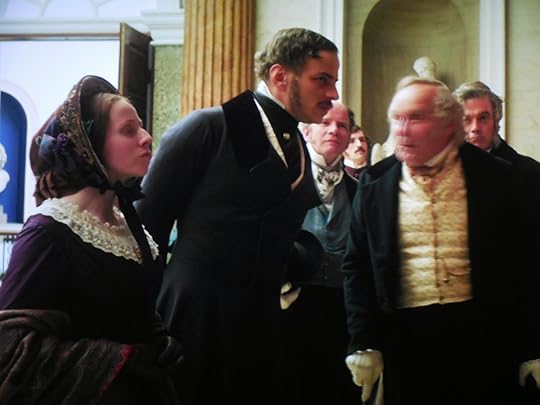
Above and below, Sinead Matthews as Queen Victoria and Tom Wlaschiha as Prince Albert
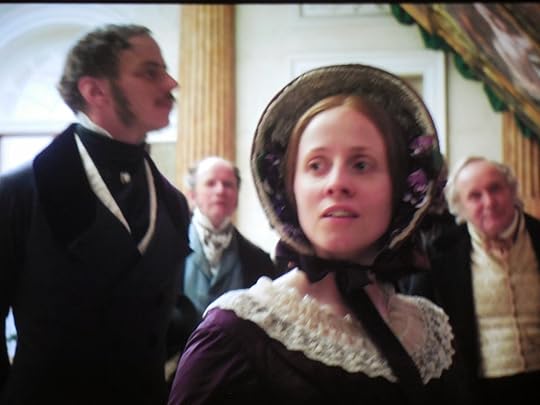
Among the many prominent artists portrayed, but rarely specifically identified, in addition to those mentioned, are Sir William Beechey, Sir John Soane, Sir Charles Eastlake, and Henry William Pickersgill. Another was the scientist and mathematician Mary Somerville, one of the first two women members in the Royal Astronomical Society (along with Caroline Herschel). Somerville College was named for her, one of the first women's colleges at Oxford University. Next time I see the film, probably on DVD, I will endeavor to identify more of these characters.
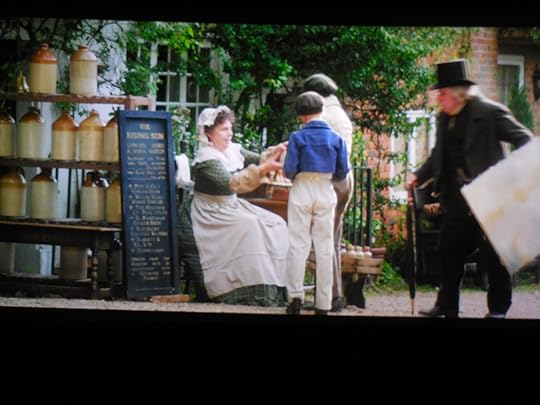
As you can tell from the pictures, the costumes and settings are exceedingly good. Obviously they were well researched. For one a bit familiar with changes in fashion from the 1820's to the 1850's, I think I can verify their accuracy.
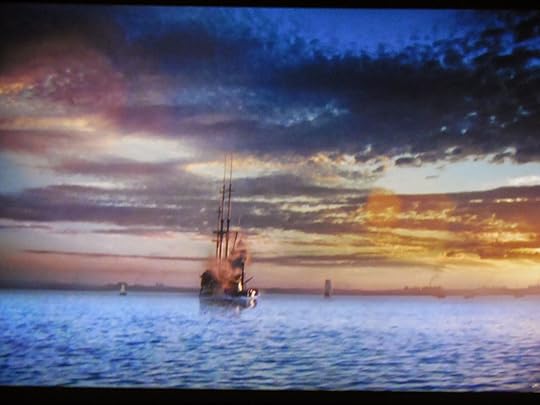
In 2005, the BBC conducted a poll to identify Great Britain's favorite work of art. The winner was The Fighting Temeraire, by Turner. This film shows Turner encountering the old ship, once the pride of His Majesty's Navy, being towed away to be broken up.
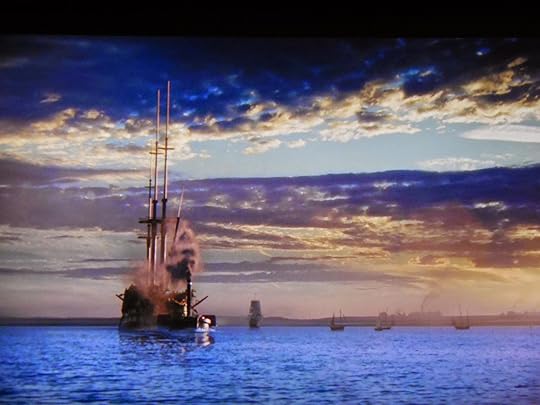
Turner completed the painting in 1838 and exhibited it at the annual Royal Academy Exhibition in 1839.
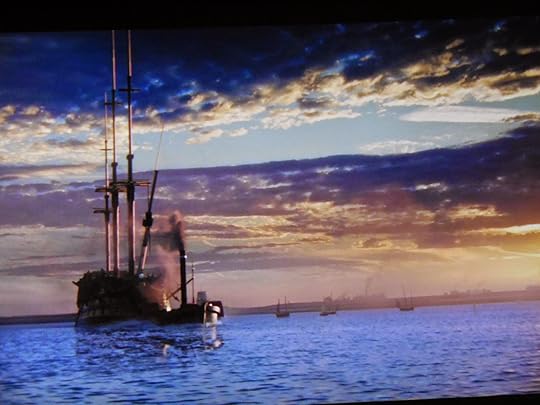
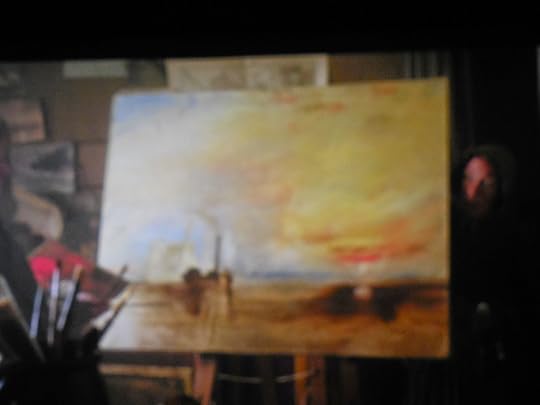 The work in progress in the film
The work in progress in the film
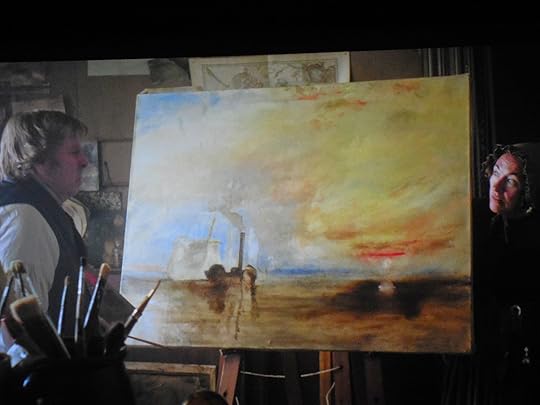
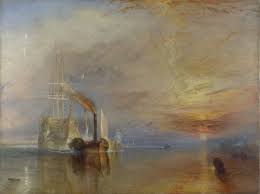 Image of the painting from the website of the National Gallery where it hangs permanently.
Image of the painting from the website of the National Gallery where it hangs permanently.
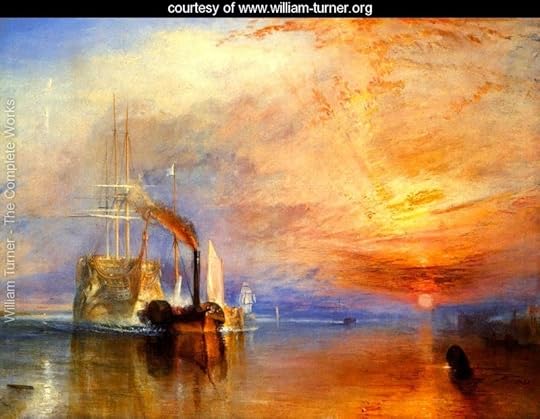 A brighter version of the painting, from the Turner website.
A brighter version of the painting, from the Turner website.
Personally, I love The Fighting Temeraire, and many other Turners. I have spent quite a bit of time at the Tate Britain in the Clore Gallery where most of his paintings are displayed, and I find them all delicious, whether line-for-line almost photographic in detail or atmospheric and abstract. I think my all time favorite, however, is one I remember from a childhood poetry book. Tintern Abbey.
 Watercolour of Tintern Abbey, Turner, 1794
Watercolour of Tintern Abbey, Turner, 1794
Another of my favorites, because it is so dramatic and does not glorify the battlefield is Waterloo, which hangs in the Tate Britain. The Tate holds more than 500 oil paintings, 2,000 watercolours, and 30,000 works on paper from the Turner Bequest. Funds were also left by Turner, who had achieved financial success earlier than most artists, to assist elderly artists. The Turner Prize was established to honor contemporary artists as well.
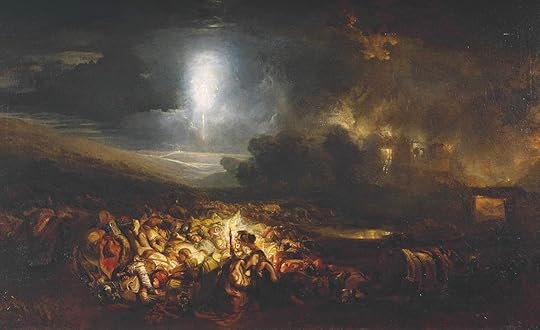 The Field at Waterloo, exhibited 1818.Tate Britain
The Field at Waterloo, exhibited 1818.Tate Britain
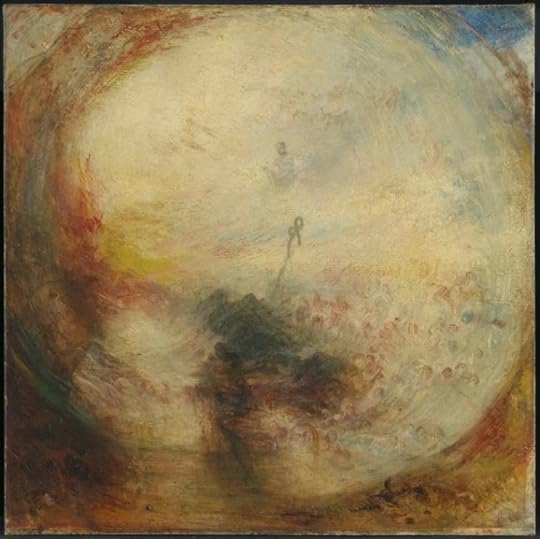 Light and Colour (Goerthe's Theory) - the Morning after the Deluge - Moses Writing the Book of Genesis, exhibited 1843
Light and Colour (Goerthe's Theory) - the Morning after the Deluge - Moses Writing the Book of Genesis, exhibited 1843
In 2014, the Tate Britain mounted an exhibition Late Turner: Painting Set Free: works after 1835 the year he turned 60.
From the exhibition description: "During his final period Turner continues to widen his exposure in the marketplace. From pictures of the whaling industry ni the 1840's to 'sample studies' and finished watercolours such as The Blue Rigi Sunrise 1842 (Tate), he constantly sought to demonstrate his appeal to new admirers, led by John Ruskin, who famously described Turner as 'the greatest of the age.'"
The exhibition closed in London last month. It opens at the J. Paul Getty Museum, Los Angeles, on February 24 and continues until May 24, 2015. It will be shown at the deYoung Museum, San Francisco, June 20-September 20, 2015.
Following our wonderful hours in the theatre, Kristine and I simply had to have some refreshments over which to deconstruct the the film. A perfect day, at least as perfect as one could be on this side of the pond.
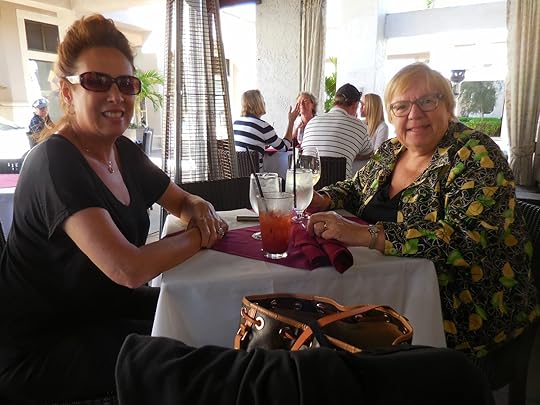
 Poster for the film Mr. Turner
Poster for the film Mr. TurnerBut, wonder of wonders, it reappeared at local cinemas; Kristine and I made a date to see the film on a sunny Sunday afternoon in Ft Myers FL.
To watch the official trailer, click here.
 Timothy Spall is brilliant in the title role; he has already won many Best Actor Awards, including at the Cannes Film Festival, and he deserves even more.
Timothy Spall is brilliant in the title role; he has already won many Best Actor Awards, including at the Cannes Film Festival, and he deserves even more. Though the quality of this snapshot hardly does it justice, the cinematography was incredible.
Though the quality of this snapshot hardly does it justice, the cinematography was incredible.Director Mike Leigh apparently was passed over for nominations for BAFTAs and Oscars, though he too has won several awards and deserves more. But Mr. Turner is not your average blockbuster popular film, aimed at massive audiences, though I hope it gets widespread distribution anyway.

The film follows Joseph Mallord William Turner ((1775 - 1851) in later life, when he had already earned a distinguished reputation, particularly for his landscapes and nautical scenes. He is a curmudgeonly character, abrupt and eccentric, unkind to the mother of his children, to those daughters (which he apparently did not acknowledge as his), and was abusive to his housemaid, Nevertheless he was a magnificent artist, and it is great film.
 Petworth House, West Sussex
Petworth House, West SussexTurner visited almost annually at Petworth House, home of the 3rd Earl of Egremont. He painted both inside the house and on the grounds.Some scenes of the movies are set at Petworth and you can read about the filming there by clicking here.
 Filming at Petworth NT
Filming at Petworth NTPetworth is now operated by the National Trust. A magnificent collection of paintings is on view there, as well as the fascinating interiors, even the kitchens, and the grounds too. For more information, click here. The NT has mounted a special exhibition related to the film, on display until March 11, 2015, at Petworth.
 Scenes set at the Royal Academy annual exhibitions were especially interesting, with their portrayals of so many of our favorite artists, including John Constable and Benjamin Haydon, below, played by Martin Savage. Relationships among the artists were often prickly and one can hardly be surprised that the competitive spirit reigned.
Scenes set at the Royal Academy annual exhibitions were especially interesting, with their portrayals of so many of our favorite artists, including John Constable and Benjamin Haydon, below, played by Martin Savage. Relationships among the artists were often prickly and one can hardly be surprised that the competitive spirit reigned.
More comfortable was the growth of Turner's relationship with Mrs. Booth, a widow from Margate, Kent, where he want to paint the sea. Mrs. Booth is sympathetically portrayed by actress Marion Bailey. He bought her a house in Chelsea where they lived together for many years.


 Dorothy Atkinson as Hannah Danby, Turner's housemaid
Dorothy Atkinson as Hannah Danby, Turner's housemaidAtkinson gives an amazing performance as Hannah, who grows ever more pitiable as she endures his moods, his mistreatment, her own growing strangeness and affliction. I was surprised when looking at the cast listing to find that Hannah Danby was the niece of Sarah Danby, the woman who claimed to have had two daughters with Turner, though they were never married.
Another performance, hardly more than a cameo, interested me because I've seen Sylvestra Le Touzel in several films and on the London stage.
 Sylvestra Le Touzel as John Ruskin's mother
Sylvestra Le Touzel as John Ruskin's mother Le Touzel as Fanny Price in the 1983 BBC production of Mansfield Park
Le Touzel as Fanny Price in the 1983 BBC production of Mansfield ParkMentioning Ruskin brings up two aspects of the film that I didn't like. John Ruskin (1819-1900) was a great authority on Victorian Art, a painter himself, and, I believe a worthy critic who admired Turner's work. But in this film version he is about as obnoxious a dandy as possible. Too see a critique from The Guardian on the subject, click here.
 Joshua McGuire as John Ruskin
Joshua McGuire as John RuskinThe second thing I disliked was the cliched representation of Queen Victoria and Prince Albert as disliking Turner's work and denigrating it as the product of failing eyesight. I know they liked the work of Landseer, Leighton, and Winterhalter, but I wonder if the opinions expressed in the film are quite right. Of course, as a Victoria myself, I always give her the benefit of the doubt -- she was certainly the object of many unflattering statements by those who should have known better!!

Above and below, Sinead Matthews as Queen Victoria and Tom Wlaschiha as Prince Albert

Among the many prominent artists portrayed, but rarely specifically identified, in addition to those mentioned, are Sir William Beechey, Sir John Soane, Sir Charles Eastlake, and Henry William Pickersgill. Another was the scientist and mathematician Mary Somerville, one of the first two women members in the Royal Astronomical Society (along with Caroline Herschel). Somerville College was named for her, one of the first women's colleges at Oxford University. Next time I see the film, probably on DVD, I will endeavor to identify more of these characters.

As you can tell from the pictures, the costumes and settings are exceedingly good. Obviously they were well researched. For one a bit familiar with changes in fashion from the 1820's to the 1850's, I think I can verify their accuracy.

In 2005, the BBC conducted a poll to identify Great Britain's favorite work of art. The winner was The Fighting Temeraire, by Turner. This film shows Turner encountering the old ship, once the pride of His Majesty's Navy, being towed away to be broken up.

Turner completed the painting in 1838 and exhibited it at the annual Royal Academy Exhibition in 1839.

 The work in progress in the film
The work in progress in the film

 Image of the painting from the website of the National Gallery where it hangs permanently.
Image of the painting from the website of the National Gallery where it hangs permanently. A brighter version of the painting, from the Turner website.
A brighter version of the painting, from the Turner website.Personally, I love The Fighting Temeraire, and many other Turners. I have spent quite a bit of time at the Tate Britain in the Clore Gallery where most of his paintings are displayed, and I find them all delicious, whether line-for-line almost photographic in detail or atmospheric and abstract. I think my all time favorite, however, is one I remember from a childhood poetry book. Tintern Abbey.
 Watercolour of Tintern Abbey, Turner, 1794
Watercolour of Tintern Abbey, Turner, 1794Another of my favorites, because it is so dramatic and does not glorify the battlefield is Waterloo, which hangs in the Tate Britain. The Tate holds more than 500 oil paintings, 2,000 watercolours, and 30,000 works on paper from the Turner Bequest. Funds were also left by Turner, who had achieved financial success earlier than most artists, to assist elderly artists. The Turner Prize was established to honor contemporary artists as well.
 The Field at Waterloo, exhibited 1818.Tate Britain
The Field at Waterloo, exhibited 1818.Tate Britain Light and Colour (Goerthe's Theory) - the Morning after the Deluge - Moses Writing the Book of Genesis, exhibited 1843
Light and Colour (Goerthe's Theory) - the Morning after the Deluge - Moses Writing the Book of Genesis, exhibited 1843In 2014, the Tate Britain mounted an exhibition Late Turner: Painting Set Free: works after 1835 the year he turned 60.
From the exhibition description: "During his final period Turner continues to widen his exposure in the marketplace. From pictures of the whaling industry ni the 1840's to 'sample studies' and finished watercolours such as The Blue Rigi Sunrise 1842 (Tate), he constantly sought to demonstrate his appeal to new admirers, led by John Ruskin, who famously described Turner as 'the greatest of the age.'"
The exhibition closed in London last month. It opens at the J. Paul Getty Museum, Los Angeles, on February 24 and continues until May 24, 2015. It will be shown at the deYoung Museum, San Francisco, June 20-September 20, 2015.
Following our wonderful hours in the theatre, Kristine and I simply had to have some refreshments over which to deconstruct the the film. A perfect day, at least as perfect as one could be on this side of the pond.

Published on March 02, 2015 00:30
February 27, 2015
LOOSE IN LONDON: WE LOSE VICTORIA
In our last Loose in London post, Victoria set the scene by describing all we saw at the Queen's Gallery, one of my favourite places. I love the exhibits they put on - the topics are always of personal interest in themselves, the items well chosen and the Gallery space itself of a size that still manages to seem intimate.
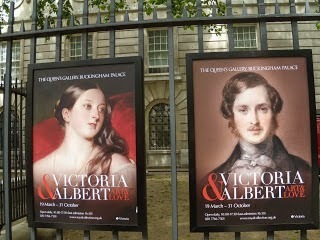
Back in 2010, Victoria and I had attended the Art In Love exhibit, which was comprised of all manner of artwork, jewels and other fabulous items that Queen Victoria and Prince Albert had exchanged as gifts between themselves on various occasions over the years. You can read the post about that visit here.
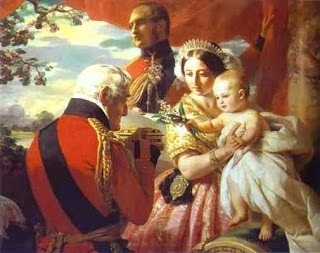
One of my favourite pictures from that exhibit was Winterhalter's paintimng, above, showing the Duke of Wellington presenting a gift to his namesake, Victoria's son, Prince Arthur, on the boy's first birthday.
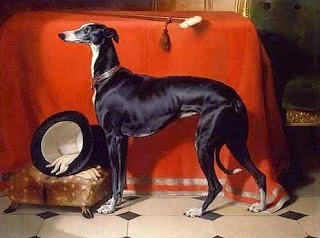
However, my favourite picture - either from that exhibit or from all time - was Landseer's painting of Prince Albert's greyhound, Eos. Queen Victoria had to smuggle Albert's cane, top hat and gloves out of the Castle and over to Landseer to use in the painting without Albert discovering why until the painting was ready for gifting. This picture does not do justice to the stunning craftmanship of the painting, which is almost photographic. I sat on a bench in front of it for nearly an hour. Then I marveled at the fact that Victoria and I were being given the opportunity to see so many favourite, so many iconic, paintings in the same room.
The First Georgian's exhibits we saw in September was not exactly up my alley, being, strictly speaking, before my chosen time period. Realizing that that train of thought sounded closed minded and, admittedly, faintly ridiculous if one aspires to be at all fair, I made my upstairs to the Galleries and was gobsmacked to see the complete, original series of Hogarth's The Harlot's Progress on display. Maybe this show wouldn't be a miss after all.
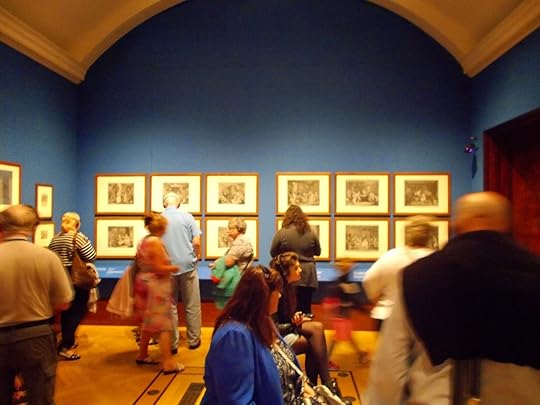
As so often happens during trips to galleries or museums, Marilyn, Diane, Victoria and I soon all went our separate ways in order to focus our attention on those things that interested us individually. After a goodly amount of time, Diane, Marilyn and myself found ourselves together once more.
"Where's Victoria?" Marilyn asked.
"No idea," I answered, "but come to think on it, I haven't seen her for quite a while."
"We haven't, either," said Diane. "We'll go and look for her."
"No," said I, putting a restraining hand on Diane's arm. "Let's make a plan first, so that we don't lose anyone else." I thought for a moment, channeling Wellington and hoping some of his strategic savvy would rub off on me. "Okay, here's the deal. I'll wait right here (we were in the largest gallery, with most rooms opening off of it). You go that way, and Diane, you go that way. What time is it?"
"10:50," Marilyn said, checking her watch.
"Right," I said, "both of you will be back here by 11 o'clock. I won't move."
So off they went. And back they came with a few minutes to spare.
"No Victoria." Marilyn said, looking at me expectantly.
"Where on earth can she be?" Diane murmured.
"We have to be just missing her. Like something out of a Marx Brothers movie," I said. "Tell you what, let's go out to that half wall right outside the Gallery and wait for her there."
So off we went, down the stairs, when Diane had a brilliant idea, "Maybe she's in the giftshop?"
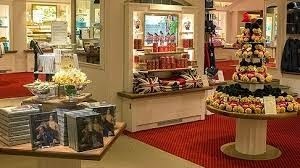
The three of us made a thorough search of the giftshop. We checked every nook and cranny in every section. It's a wonder we didn't get hauled in for casing the joint. No Victoria. So off we went, out the door and over to the half wall that fronts Buckingham Palace Road. It's hard to believe, but I haven't a single photo of the wall. Can't even find one on Google. Hard to believe because Victoria and I are well acquainted with the wall. We've sat on the wall many times. We've used the wall as a meeting post on numerous occasions. And you may remember that this was the exact same wall on which Victoria had left her camera just a few days ago. I felt certain that Victoria, once realizing that we'd been separated, would make a bee line for this wall as a point of re-connection.
So, there the three of us sat.
"I can't imagine where she can be," mused Diane.
"How could we lose her? The Gallery isn't that big," Marilyn added.
"This does not bode well," I said.
"Oh, it's not that bad. She'll turn up," Diane said.
"I meant that it doesn't bode well for the Duke of Wellington tour. It hasn't even begun yet and I've lost someone. And not just someone, but Victoria, my co-guide. If I can't keep track of a tour guide, how am I supposed to keep track of seventeen tour goers?"
We sat pondering the answer to this question for some time. Some long time.
"I'm going back inside the Gallery to see if she's there," I told them. "Don't move from this spot!"
Once back inside, I cased the giftshop. Again. Then I went up to the information desk and explained my dilemma to the kind lady behind the desk, giving her Victoria's name and telling her where we'd be waiting, just in case Victoria thought to ask at the desk. Then, I asked one of the guides if she'd go back upstairs into the Gallery and look for Victoria, which she did, using my description of Victoria to scout any lost women she may find. She came back to say that she hadn't found anyone who looked lost or bewildered, nor anyone matching Victoria's description, nor by discreetly having called Victoria's name in various rooms. She even checked the bathrooms. No Victoria.
So I want back outside and told the girls that I was going to walk down to the Palace entrance to see if somehow Victoria had left the Gallery before us and was waiting for us there. I went. I looked. No Victoria. I went back to the wall and sat down beside Marilyn and Diane.
"Where can she be?" I asked no one in particular. "I mean, it's not like the Gallery is all that big."
"And she's not in the gift shop or the bathroom," Diane added.
"And she wouldn't just leave us there," Marilyn said. "I mean, the plan was for the four of us to go on to the Palace together. Why would she leave without us?"
"She's not any place that makes sense. She can't still be inside. She wasn't at the wall and we haven't crossed paths in quite some time. Weird. It's like someone came down and abducted her."
"Yeah, but instead of aliens, it was Prinny who whisked her away to Regency England in another dimension," Diane said. "Maybe she's eating ices at Gunter's as we speak."
"She'd better not be," I replied. "I wish we could fast forward to when we find her so that I'd have the explanation. The suspense is killing me cause I can't for life of me think where she could be that we haven't seen hide nor hair of her." I stood up, "I know it makes no sense, but I'm going to walk up to the Royal Mews gift shop and see if she's there. Unlikely, but we'll then be able to rule that out. Don't move!"
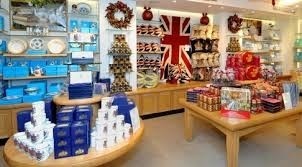
So, off I trod, up Buckingham Palace road to the Mews giftshop. No Vicky. On my way back, I stopped into the gallery again. "I know this sounds dramatic," I said to the lady behind the information desk, "but you haven't anyone fallen ill, have you?"
"You still haven't found your friend?" she asked.
"No, and just to cover all the bases, I wondered if something happened."
"No, sorry, we haven't had anyone fall sick, or injure themselves or anything else. Certainly nothing that required emergency services, either. Sorry."
Dejected, I walked back to the wall. "How long have we been sitting here?"
"Almost an hour," Marilyn said.
"And no sign of her, I said. "I'm going to go out on a limb here and say that the chances of her walking by now are slim to none."
"Well, we might as well go on to the Palace for the tour, as planned," suggested Diane. "If worse comes to worse, we'll find her later at our hotel."
So off we trudged. Each of us still musing on where in the world, or in London at any rate, Victoria could be. Honest to God, if she had gone to Gunter's without me, I'd throttle her.
Note from Victoria: I was looking for them, and beginning to suspect I'd been ditched..a la junior high school, the mean girls had conspired to leave me behind!
More Loose In London Coming Soon!
Published on February 27, 2015 00:00
February 25, 2015
MR. COKE OF NORFOLK
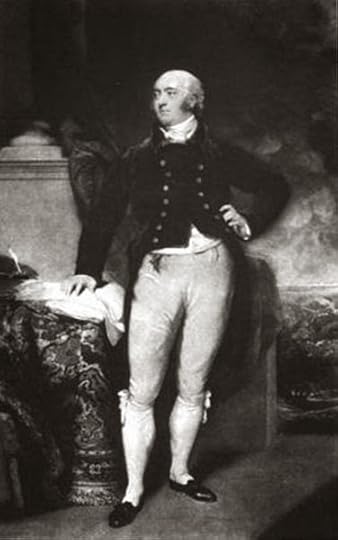
From Mrs. Arbuthnot's Journal - February 25, 1822
I have been very much astonished, in common with the whole town, at the marriage of my old friend Mr Coke of Norfolk, who at the age of 69, has taken Lady Ann Keppel, a girl of 19. It is said she first wished to marry his nephew and heir, William Coke, and, failing with him, turned her attention upon the old man. It is very disgusting, I think, in both lady and gentleman; the latter, however, called on me yesterday and seemed rather proud and to think he was going to do a very clever thing. I wish he may find it answer, but I doubt it much.
You can read more about the Cokes in Victoria's past posts about her visit to their home, Holkham House - Part One can be found here and Part Two here.
Published on February 25, 2015 00:00
February 22, 2015
WELLESLEY POLE AND THE BANK OF ENGLAND
With many thanks to Greg Roberts for his kind permission to reprint this article from his fabulous website called:
Wicked WilliamResources for study of the life and times of William-Pole-Tylney-Long-Wellesley (1788-1857)The Mint with a Pole – Part 4orWhen Wellesley-Pole made money quicker than his son spent itIn 1816 the euphoria of victory at the Battle of Waterloo wore off and Britain entered a period of unrest. Corn prices were set at an artificially high level by the Importation Act (1815) – or Corn Laws as they became known – benefitting wealthy landowners at the expense of the poor. A bad harvest, the return of thousands of soldiers from Europe, and demonstrations against working conditions combined to increase tension, leading to repressive counter-measures from the Government. Against this backdrop, the Coinage Bill was passed on 22 June 1816, and Wellesley-Pole was ordered to draw up a plan to replace the silver coinage.Wellesley-Pole’s schedule detailed how he proposed to design, manufacture, and distribute the new coinage. It also outlined a system for recovering the old money for the Bank of England. He started entirely from scratch after realising there was ‘no collection of British coins in His Majesty’s Mint…not a single Proof.’ To ensure this would never happen again, he founded a Museum to house ‘every coin and medal which, from this time forth, shall be struck’. In July 1816 Banks supplied Wellesley-Pole with old coins as a basis from which the new currency could be created.This collection now forms the backbone of the Royal Mint Museum.
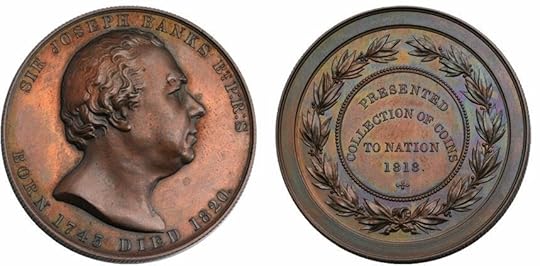
Joseph Banks donated coins to enable Wellesley-Pole to set up Mint Museum
The key problem was how to undertake an operation of this magnitude without alerting the nation as to what was afoot – and once the coinage was manufactured – how to distribute it to the four corners of Britain so that it might appear simultaneously on ‘Great Re-coinage Day’. Wellesley-Pole had to do this at a time of immense social unrest, using the most rudimentary of transport and communication systems. Some boxes of coin were shipped to northern ports but the vast majority went by carriage up and down Britain’s roadways – with accompanying detailed instructions to be acted upon at each and every destination. Getting the new coinage to these outlets was one thing, but Wellesley-Pole was also tasked with rounding up all the old silver currency in exchange for new crowns, shillings and sixpences. This redundant money had to return to the Mint by the same arduous process after the two-week exchange period expired.
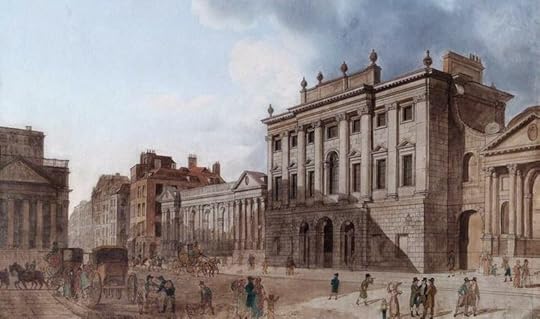
The Bank of England – Pivotal to Wellesley-Pole’s plans
The National Archive reveals that Wellesley-Pole submitted his plan on 16th September. He confirmed an agreement with Governor of the Bank of England that banks throughout Britain would assist in the transfer ‘without looking for any remuneration… Considerable expense must be saved from the many applications that have been made in favour of persons wishing to be employed in the issue and exchange of the new money’. He further curtailed costs by creating accounts with every participating bank for the money distributed to and collected from them. Sir Joseph Banks described his plan as
excellently arranged…I have seen a multitude of public men, but no one whose conduct has been as energetic and so perfectly successful’.A week later Wellesley-Pole received approval from the Prime Minister Lord Liverpool, subject to proceeding in complete secrecy until the money was ready to be circulated.
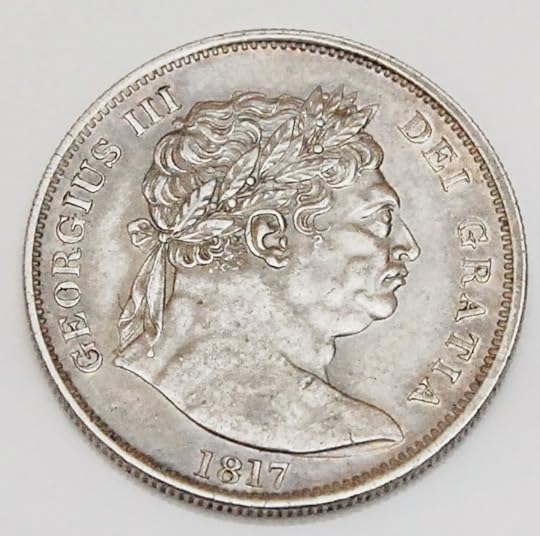
Pistrucci was unable to draw mad King George III from life – This ‘bull head’ image was heavily criticisedEach coin was approved by the Prince Regent prior to manufacture. Wellesley-Pole enthused the coins were ‘absolutely divine’. Every last detail was meticulously planned. Coins were labelled and bagged in sums of £100. Bags were then packed into a sturdy box containing £600 comprised of one bag of half crowns, four bags of shillings and one of sixpences. The destination of each box was labelled and arrangements were made for them to be re-used for the return of old coinage after the exchange was completed. 57 million coins were ready for distribution by January 17th 1817. A few days later Wellesley-Pole called a meeting of the bankers of London proposing:
That all 72 London banks be ‘furnished with money to exchange the silver coin…by opening all their shops to the public at large. Inspectors from the Mint to be established in each shop for selecting…the old coin to be recovered…by which means Bankers would be exonerated from any responsibility.
Every Banker in England, Scotland and Wales to employed in likewise manner but ‘the Country Bankers’ to recommend such persons for inspectors as they conceive to be trustworthy.Wellesley-Pole earmarked the operation for 3rd February, but the London Bankers, worried about civil unrest, feared that by opening to the general public ‘their property would be endangered’. So the Master of the Mint was compelled to hastily arrange alternative locations for public distribution. He ensured that a comprehensive network of outlets were created in every principle town in England and Wales, which received almost £1.8M by February 3rd.
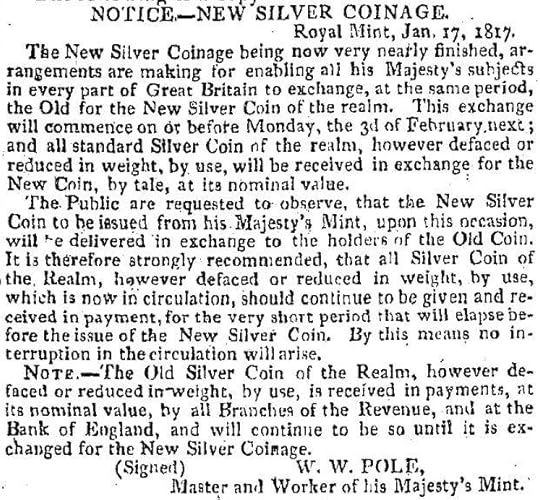 Cat out of bag 18th Jan 1817 – Wellesley-Pole announces Great Re-CoinageThe exchange for Scotland was undertaken by the Bank of Scotland who acted under a letter of instruction from the Master of the Mint, so the entire operation hinged on Wellesley-Pole’s meticulous planning.The Cabinet eventually deferred the exchange until February 13th. But it was completed in 14 days as planned and the old currency ceased to be legal tender on March 1st. These remarkable statistics bear testimony to the success of this operation
Cat out of bag 18th Jan 1817 – Wellesley-Pole announces Great Re-CoinageThe exchange for Scotland was undertaken by the Bank of Scotland who acted under a letter of instruction from the Master of the Mint, so the entire operation hinged on Wellesley-Pole’s meticulous planning.The Cabinet eventually deferred the exchange until February 13th. But it was completed in 14 days as planned and the old currency ceased to be legal tender on March 1st. These remarkable statistics bear testimony to the success of this operationOf £2,6000,000 delivered not one bag or box of new coin was mislaid and there does not remain a single complaint of deficiency of money for exchange in every part of Great Britain. In carrying the measure through, the Mint dealt with over 14000 letters and employed 1000 inspectors. 469 accounts with individual banks were reconciled ‘to the penny’ when the old currency was returned.By any standard this operation was an astounding success. Because it went without a hitch it was soon forgotten, perhaps the biggest single reason why Wellesley-Pole is mired in obscurity. It was only when the House of Commons debated currency in 1842, that the enormity of his achievements were highlighted against shortcomings in current procedures.As we have seen in Pole and Pistrucci the Great Re-Coinage failed to ignite public excitement, and the press preferred to continue their campaign of back-biting and ridicule against both men.The only reply either man can give in answer to their critics is to emphasise that the silver coinage remained in circulation until 1971 – Yes that’s 154 years!In my final part I will look at Wellesley- Pole’s departure from the Mint and round up his legacy…..
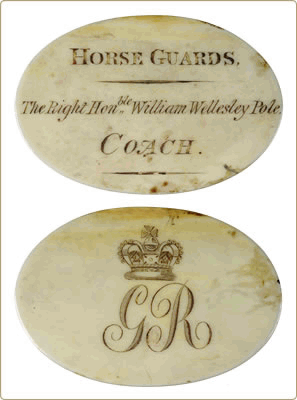
So you have seen how, at least for a few years, Wellesley-Pole made money faster than his feckless son Wicked William of Wanstead House was able to spend it. Follow Wicked William to the Epping Hunt, or off to War with Wellington or find out what happened when Wellesley-Pole’s rage got the better of him.Finally, I have written the remarkable history of Wellesley-Pole’s houseI hope you enjoy this post and would be most grateful to hear any feedback.Sources UsedRoyal Mint WebsiteThe National Archives (Kew) Mint 1/56Bagot J., George Canning and Friends (London: Murray, 1909)Senate House Library, Mint Book MS499Greg Roberts unpublished dissertation The Forgotten Brother (2009)Image of Sir Joseph Banks by William Wyon courtesy of the Royal Mint Museum
You'll find Greg's website Wicked William here.
 Follow Greg Roberts on Twitter @geggly
Follow Greg Roberts on Twitter @geggly
Published on February 22, 2015 23:00
February 20, 2015
ROYAL DAY OUT, PART TWO: THE QUEEN'S GALLERY
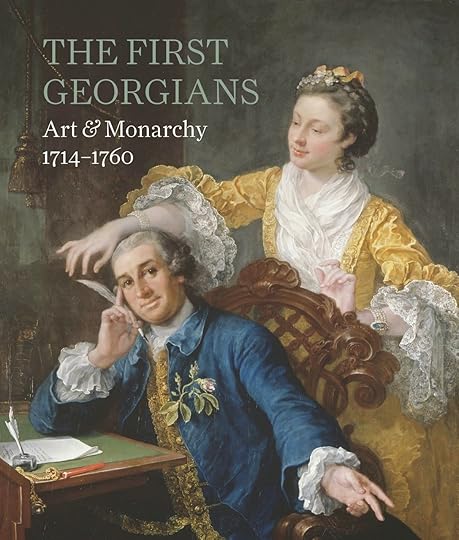
Victoria here.The second venue in our Royal Day Out was the Queen's Gallery, actually, like the Mews, a part of the Buckingham Palace complex, and one that you may visit almost year-round.
Below, a view of the entrance to the Queen's Gallery when Kristine and I visited for the exhibition Victoria and Albert: Art and Love in 2010.
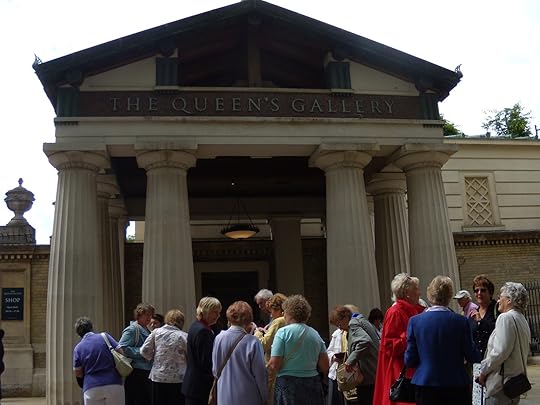
The First Georgians celebrated the tricentennial of the accession of the House of Hanover to the English Crown, When Queen Anne died in 1714, it had been decided that her successor would be Electress Sophia of Hanover or her issue. Despite at least seventeen pregnancies, none of Anne's children had survived to adulthood. The British Parliament was determined the monarchy would not go to a Roman Catholic so they disallowed all the family of the former king, James II and the Stuarts.
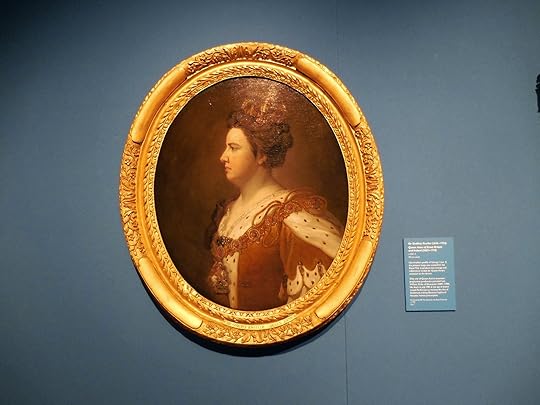 Queen Anne of Great Britain and Ireland (1665-1714) c. 1702-04by Sir Godfrey Kneller (1646-1723)
Queen Anne of Great Britain and Ireland (1665-1714) c. 1702-04by Sir Godfrey Kneller (1646-1723)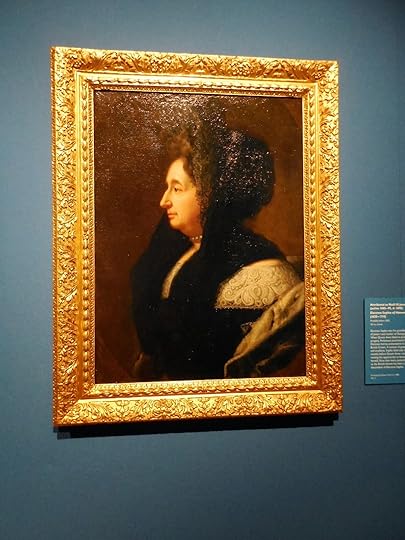 Sophia Electress of Hanover (1630 -1714)attributed to Noel III JouvenetSophia was the granddaughter of King James I.
Sophia Electress of Hanover (1630 -1714)attributed to Noel III JouvenetSophia was the granddaughter of King James I.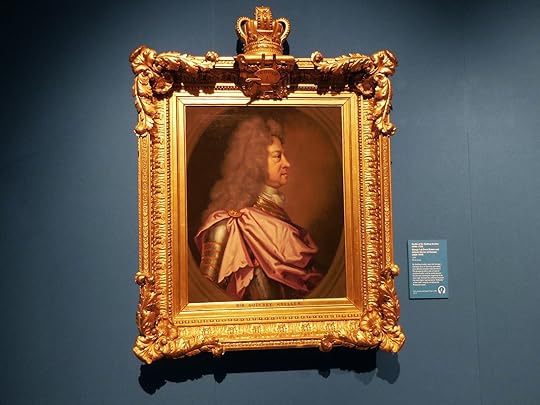 George I of Great Britain and Ireland (1660-1727)Studio of Sir Godfrey Kneller
George I of Great Britain and Ireland (1660-1727)Studio of Sir Godfrey KnellerTo quote from the text panel, "Dressed like a Roman Emperor, the new king is represented as 'Defender of the Faith' ready to champion the Protestant cause." George I never learned to speak English well and spent a great deal of time in his home state of Hanover.
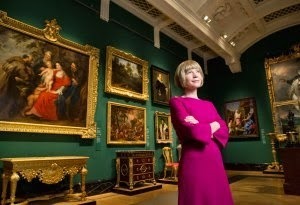 Dr. Lucy Worsley's series The First Georgians ran on the BBC in 2014.Click here to watch.
Dr. Lucy Worsley's series The First Georgians ran on the BBC in 2014.Click here to watch.From Dr. Worsley's website: "The series tells the story of George I, George II and their family... I was given access to treasures from the Royal Collection as they were prepared for a new exhibition at the Queen’s Gallery, Buckingham Palace – providing a rare and personal view of George I and his feuding dynasty.The Hanoverians arrived at a moment when Britain was changing fast. We looked at satire, gin-drinking, smallpox, the slave trade, the crushing of rebellion and the building of an empire – all at a time when Britain was embracing freedom of speech and modern cabinet government."
Dr. Worsley, chief curator at Historic Royal Palaces, also writes of the First Georgians on her blog, here.
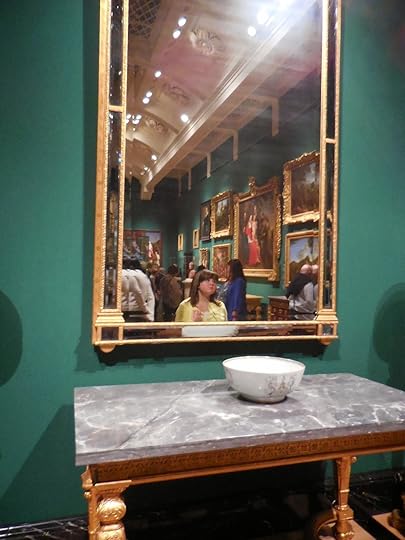
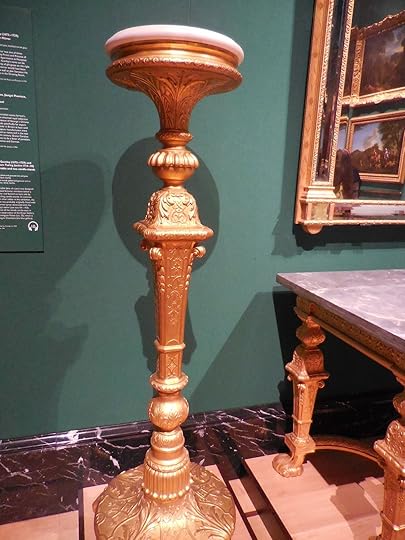 Two pictures above: Mirror, Table and Candle-Standby John Gumley and William Turing, c. 1727
Two pictures above: Mirror, Table and Candle-Standby John Gumley and William Turing, c. 1727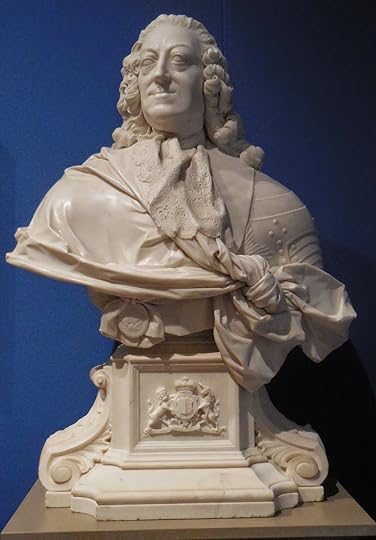 George II 1683-1769, c. 1760by Louis-Francois Roubiliac 1702-62
George II 1683-1769, c. 1760by Louis-Francois Roubiliac 1702-62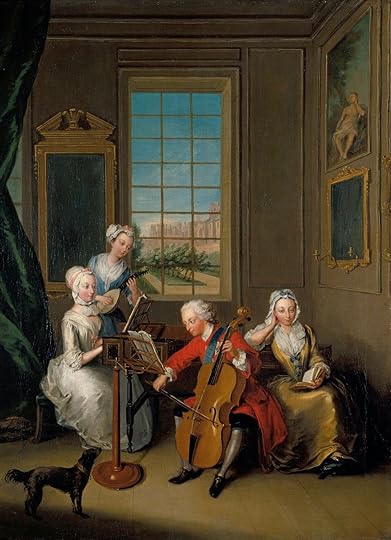 The Music Party: Frederick, Prince of Wales with His Three Eldest Sisters, 1733by Philippe Mercier (1689-1760)
The Music Party: Frederick, Prince of Wales with His Three Eldest Sisters, 1733by Philippe Mercier (1689-1760)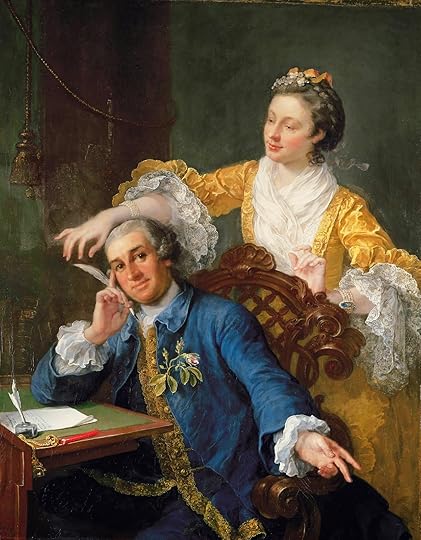 David Garrick with His Wife Eva-Marie Veigel c. 1757-64by William Hogarth 1697-1764
David Garrick with His Wife Eva-Marie Veigel c. 1757-64by William Hogarth 1697-1764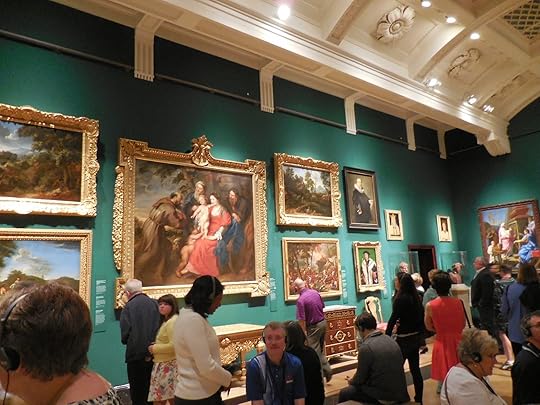 The Queen's Gallery was crowded with viewers, most eager to get along to the next stage of the Royal Day Out: Buckingham Palace. But wait until you hear what happened to me! Remember, I am the one who insists on reading (almost) every word of every text panel along the way.
The Queen's Gallery was crowded with viewers, most eager to get along to the next stage of the Royal Day Out: Buckingham Palace. But wait until you hear what happened to me! Remember, I am the one who insists on reading (almost) every word of every text panel along the way.More Loose In London Coming Soon!
Published on February 20, 2015 00:00
February 17, 2015
WATERLOO WEDNESDAY - THE ITALIAN CONNECTION
From Adventures In Historyland
Waterloo being what it is, all you hear about in terms of British allies, is the Prussians, the Belgians and the Dutch. It may of interest to you good readers, to hear about the Italian connection and the story of a little known Waterloo Man.
To begin with there is the Corsican. As British contemporary caricaturists loved to point out, Napoleon was French by adoption rather than birth. To me this still makes him more French than Italian but on a purely factual level they were correct. Napoleon was not the only Corsican on the field however, on the other side of the shallow valley of Mont St Jean was Count Pozzo di Borgo, Russian diplomat and Military observer for the Tsar, attending on Louis XVIII at Ghent, who suffered a contusion while riding with Wellington’s staff at Waterloo. The Duke asked him to write the letter to Louis confirming Napoleon’s defeat that evening.
Paolo Francisco, Count De Sales, was doing a similar job to di Borgo. He was born in Savoy but he owed his allegiance to the King of Piedmont Sardinia and he is remembered as one of the men who organised the Sardinian Army. He was one of the last men on the Duke’s overstretched and badly reduced staff, still available at the end of the day.
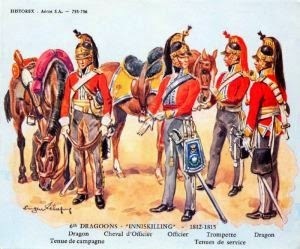
One of the most interesting is a young lieutenant of about 24, that Reese Gronow saw riding along the position with Wellington’s staff before the battle started. His name was Count Paolo Ruffo and he was the second son of the Neapolitan Ambassador to London, Fabrizio, Prince of Castelcicala. Paolo was born in Richmond in 1791 and educated at Eton and he left school in 1811 to join the British army. His father moved in elevated circles and arranging a commission for his son would not have been an obstacle. Paolo joined the 6th (Inneskilling) Heavy Dragoons and on the 3rd of May 1815 advanced to the rank of Lieutenant. A young man who would one day become a prince could be expected to be quite popular amongst fellow officers, he appears to have been fairly well known through the army in Belgium, and it is intimated that he had friends enough to gain invitation to ride on the General Staff, (Perhaps as an orderly). Wellington preferred to populate his “Military family” with bright young things from good backgrounds and Paolo certainly qualified as both.Young Ruffo’s actions during the momentous day are rather vague, though he is supposed to have garnered praise for his gallantry. Gronow saw him on the staff and he is further supposed to have “Galloped” for Wellington at least twice during the day, which rather discounts him from being with his regiment during their famous charge against D’Erlon’s Corps. Nevertheless though line officers might deride staffers for their perks and cushy appointments, in action, staff officers had one of the most dangerous jobs in the army and Wellington’s were usually with him were the fighting was thickest. Sometime after his second assignment Ruffo received a wound, I have not confirmed where he was hit, but it took him out of the battle. Indeed the inference may be that he was left on the field overnight and rescued as he is listed as “Missing”. Even if he was not lost amongst the piles of corpses, his wound was serious, a fact testified to by Dr. Samuel Cooper and the fact it took him about a year to fully recover. When news of the battle reached his mother, Giustina, she became very concerned for his safety as word came that he was missing, and then that he had been wounded, which would give her cause to thank God for small mercies.Ruffo’s singular status as heir to a distinguished title and son of a diplomatic official singled him out for help in his recovery. In 1816 the Prince Regent instructed Horse Guards to grant him a year’s pay, (£164 5s), and had his medical bills paid for. His presence at the Battle made him eligible to receive the Waterloo Medal, which was placed on his coffin at his funeral, and in 1817 he resumed his military duties, making a transfer to a more senior (and prestigious) regiment, the 4th Dragoon Guards. He served in Ireland, participating in a courts martial as Dept. Judge Advocate General, and served honourably until 1821 when he retired for health and family considerations. Though he was second son (Edward had been a Cornet in the 2nd, Queen’s, Regiment of Dragoon Guards but died in 1821) he went on to inherit his father’s title after he died of Cholera in 1832 and to serve 3 Kings of Naples, as a diplomat, (Much like the Count de Sales and di Borgo did after the war) to Russia, Britain and Austria between 1831 and 52, and became “Luogotenente generale dei reali domini al di là del Faro” of Sicily in 1855.
 Paolo Ruffo di Bagnaria, Prince of Castelcicala by William Salter 1834-40.
Paolo Ruffo di Bagnaria, Prince of Castelcicala by William Salter 1834-40. National Portrait Gallery.
While serving in his father’s old position as Neapolitan ambassador, smoothing out a rather unctuous diplomatic ruffle between Naples and London, he reacquainted himself with the Duke of Wellington who greeted him as an old friend, gaining invitations to dine with him.Despite his energy and readiness to serve he required a personal letter from the King to get him to Palermo to take the post as Viceroy, were he was faced with calming tensions that had arisen from his predecessor’s heavy handiness. He had married married the daughter of the Swiss ambassador to Paris, Madmoiselle Taddea Wilhelmina de Zeltner in 1832, and they had a daughter, Giustina Ruffo in 1839, when Wilhelmina died in 1855 he had sank into a deep depression, but he felt it his duty to obey the King.Though a firm but conciliatory policy and his efforts to modify and modernise to make better living conditions, which included putting lights in the port cities of Sicily, building a new port at Milazzo, and decreasing taxes, he became very popular. In 1857 Commissioners reported the kingdom in a perfect state, and in 1859 he was elevated to the order of St Ferdinand. He served as chief of Staff to the Bourbon army when Garibaldi invaded Sicily, the subsequent debacle prompted the Prince to tender his resignation which was accepted, and he returned to Naples where the title of Counsellor of State was conferred on him. In 1865 he was sent to Rome to await further orders which never came due to the fall of Gatae, and he went to Paris where he stayed until his death in 1865.While in London, between 1841 and 1852, he was a regular at the later Waterloo Banquets, where he was a welcome addition to the ever dwindling pool of officer’s that had been present at the battle. He was a guest at the very last dinner at Apsley House in 1852, where he sat on his host’s right. At the meal the Duke rose to falteringly gave his health.“I will give you, the health of an illustrious foreigner whom I had the honour of having under my command at Waterloo, Prince, Prince ” here, unsure as how to pronounce the title he stopped, and though all knew who he meant none had the courage to prompt him. At last Lord Sandys, who, has been Lord Arthur Hill, at Waterloo called out, “The Field-Marshal gives the health of Prince Castelcicala.”“Exactly so,” said the Duke, “That’s the name. Prince Castelcicala.”I found out about the good Prince by accident, as I did the other Italians I mentioned, I hope you enjoyed reading about this Waterloo Man as much as I did writing about him.Sources:The Sydney Morning Herald (NSW : 1842 – 1954) Friday 19 Oct 1849The Tablet, 13, 24th June 1848.The Illustrated London News, Volume 1.History of the French Revolution and of the Wars… By Christopher KellyThe Battle, By Alessandro BarberoFifty years of my life, George Thomas Kepple.Autobiography of Miss Cornelia Knight: Lady Companion to the Princess….By Ellis Cornelia Knight.The Spectator, 22 JUNE 1850,Lady De Lancey quoting Grownow http://www.gutenberg.org/files/31517/31517-h/31517-h.htmhttp://www.castelcicala.com/en/villa-castelcicalahttp://translate.google.co.uk/translate?hl=en&sl=it&u=http://www.treccani.it/enciclopedia/ruffo-di-bagnara-paolo-principe-di-castelcicala-e-duca-di-calvello/&prev=searchLe Prince de Castelcicala, 1866.Many thanks again to Josh at Adventures in Historyland for allowing us to reprint this fabulous article. Contact Josh via email - adventuresinhistoryland@gmail.comOr follow him on Twitter @LandOfHistory
Published on February 17, 2015 23:30
February 15, 2015
AT AUCTION: BONHAM'S VICTORIAN CARRIAGE AND COACHES
Following on the heels of Victoria's Friday post, Loose in London: Royal Day Out, in which she brought you our trip to the Royal Mews, we thought we'd carry on with the carriage theme - on March 7, Bonham's Oxford auction rooms will offer Carriages, Coaches and all manner of coaching accouterments for sale by auction. You can find the complete auction listing here, but we thought we'd share a few of the highlights below. Starting breaking open those piggy banks, there are some real treasures on the block.
Lot 203C.1800 SEDAN CHAIR£4,000 - 6,000
US$ 6,000 - 9,000
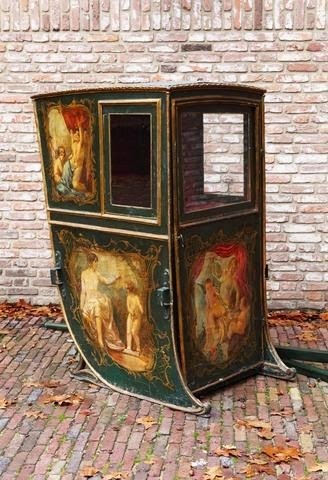
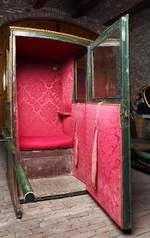
c.1800 Sedan Chair - No ReserveFOOTNOTES
Sedan chairs reached their peak across Europe in the late 1700's. They afforded a clean and safe means of transport to the nobility and upper middle classes. Many were kept inside houses where the owners could enter them before being carried out into the often, filthy streets. This sedan chair features a softwood frame construction with canvass stretched over for lightness. Externally the chair cabin is very original and would benefit from some conservation and stabilisation work. The panels depict cherubs and angels in differing scenes. The roof is leather covered, this is held in place with a carved moulding that has been picked out in gold leaf. Access to the cabin is via the front door that contains a single window, the side panels are also fitted with windows and all three can be lowered. Internally the cabin has been subject to an older restoration and is upholstered in a maroon velour material.A rare opportunity to acquire a sedan chair that would benefit from some conservation work.
Lot 205C.1880 PARK DRAGCoachwork by Holland & Holland, London, England£70,000 - 90,000
US$ 110,000 - 140,000
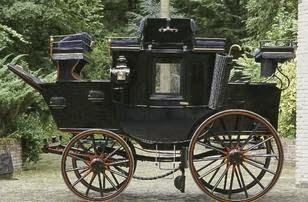


c.1880 Park Drag
Coachwork by Holland & Holland, London, EnglandFOOTNOTESHolland & Holland coachbuilders are widely regarded as building some of the finest light drags. Park Drags were used by gentlemen and ladies to attend race meetings and other events where they could be used to entertain friends and associates. Many were supplied with roof mounted picnic sets (imperials), sun shades and wine cellaretes that were contained within the rear boot.
This Park Drag is finished with a dark blue undercarriage, lower quarter panels and seat risers, the upper panels are black. The line detail is a deep red. It has been restored by Stolk of Holland and the Drag is representative of their high standard of craftsmanship. The Drag is fitted with patent mail oil axles and runs on English pattern iron shod wheels.
The passenger compartment is accessed on each side via door with a folding body step. The doors have a brass 'T' handle and there is a ivory plaque at the bottom of each door bearing the builders name. Internally the seat cushions and seat backs are upholstered in a blue wool cloth with blue tufted surface buttons and dark blue broad lace surrounds. The original oil cloth headlining has been preserved and brown leather hat straps are fitted. The window frames are finished in a blue wool cloth. Shutters are also contained within the door window recess, the nearside shutter is fitted with an internal mirror. The front internal seat back is hinged and lifting this gives access to the front boot that contains a comprehensive spares kit that includes a new set of brake shoes and supports for the roof mounted imperial. The rear boot contains correct type mahogany wine cellarets with zinc liners, with a top drawer for glasses/nappery
With the exception of minor cracks to the toe board and front boot the external coach painted mahogany panels are in very good condition. The external cushions are upholstered in blue wool cloth and the seat frames are bound in plain black leather. The roof seat lazy backs are hinged and give access to the roof mounted imperial (picnic set). With the top of the imperial removed the sides unfold to provide trays and a picnic platform. The foot platforms are covered with leather edged lino with protective pierced rubber over mats. The Coachman's toe board has a brass watch case mounted on it. A black wicker umbrella basket is fitted to the near side rear seat frame. The coachman's seat frame has a tan leather whip holder and tan leather passenger grab handles are fitted to all roof seats. Two spare bars are strapped to the rear of the grooms seat frame and a folding passenger ladder is hanging on the underside of the groom's seat. There is a coachman operated hand brake that acts on the rear wheels.
The Drag is complete with lamps (no makers name),a single lense toe board lamp team pole and bars and drag shoe. It represents a wonderful opportunity to compete at the highest level in the Coaching classes for many years to come.
Lot 210C.1890 HANSOM CABCoachwork by Forder & Co, London, England£20,000 - 25,000
US$ 30,000 - 38,000
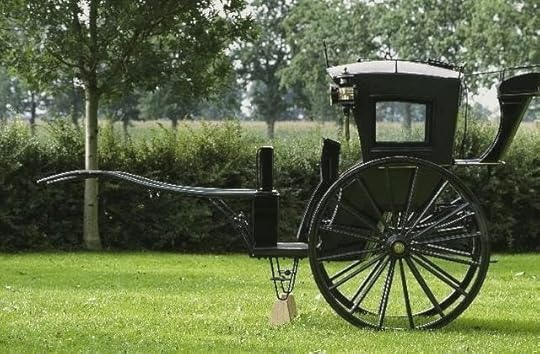
c.1890 Hanson Cab
Coachwork by Forder & Co, London, EnglandNo ReserveFOOTNOTESDesigned to convey members of the public in safety and comfort Hansom cabs became a common site of the streets of London. Today Hansom Cabs are strongly associated with late Victorian crime writers and feature in many of the famous Sherlock Holmes books. Several companies built hansom cabs but it was the coachbuilders Forder & Co who developed the best known design of Cab and the award of several medals meant that they were favoured by cab proprietors. Designed to carry two passengers the driver sat high up on the rear mounted external seat.
This Hansom Cab is finished with a light green under carriage and a contrasting dark green line. The upper body panels have been conserved and are painted black. The cab is fitted with patent collinge oil axles and runs on rubber shod warner band type wheels.
The passenger compartment is accessed via double opening doors, these are operated by the driver who would pull the leather window strap thereby 'unlocking' the doors and allowing the passenger out, prior to payment of course!, which would have been made via the small roof hatch to the rear of the passenger compartment. The seat cushion and back are upholstered in a dark green wool cloth with matching broad lace edging. The remaining surface areas are also finished in a dark green wool cloth. The metal fittings in the compartment are silver plated and there is a builders plaque mounted on the rear seat back stating that the cab is 'Public Cab � Patent Number 2209 � Royal Hansom'. There are ivory surrounds attached to two side mirrors and a rare communication whistle is also fitted so that the driver could be alerted.
Externally the driver's seat is upholstered in a green wool cloth. The roof and upper panels have been conserved but they would have originally had a highly japanned finish. The dash board is covered in polished leather and the passenger boarding platform is fitted with a pyramid rubber mat. The cab would have been drawn by a single large horse and the shafts are ash with supporting ironwork. On the underside of each step there are extended supports that the cab would have rested on when not in use. Original correct type lamps are fitted to the Cab but they do not bear the builders name.
Lot 221C.1835 TRAVELING LANDAUCoachwork by Adams & Hooper, London, England£200,000 - 300,000
US$ 300,000 - 450,000
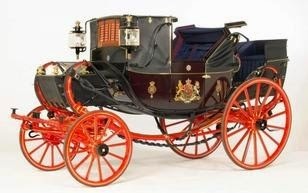
Ex-Royal British Mews, ex-James Coson Collection, Fastidiously Restored
c.1835 Traveling Landau
Coachwork by Adams & Hooper, London, EnglandFOOTNOTESThis outstanding carriage has been the subject of one of the most impressive restorations carried out in recent years.
Adams and Hooper were founded in 1805 and soon built up a reputation for building the finest carriages. From their premises in Haymarket, London, carriages were built for wealthy patrons the world over. By 1830 the company held the Royal Warrant.
Travelling Landaus were used by the nobility on extended tours throughout Britain and Europe. Designed to carry their owners in comfort over long distances they proved to be an ideal carriage prior to the introduction of the railways.
Ordered by the Royal Mews from Adams and Hooper for King William IV the Landau was delivered in 1835. The carriage would have been used by trusted representatives and possibly the King himself when undertaking long journeys. Other carriages and out riders would have formed part of the travelling entourage to carry luggage, servants and official documents. It is likely that the Landau was delivered with a detachable coachman's seat and hammer cloth, however over the course of time this has been lost. In its current configuration the Landau is arranged to by driven by postilion riders. It is uncertain why postilion riders came into being but one theory is that it allowed the occupants of the carriage to have 'open' conversations without fear of being overheard by the coachman. The Landau was sold by the Royal mews in the early part of the 20th Century. Following its sale from the Mews its history is uncertain but it was probably saved because of its 'Royal' history and provenance. Eventually it was acquired by the famous American collector James Coson and is featured in the book of his collection published in 1989, complete with a foreword from His Royal Highness Prince Philip. When the Coson collection was sold its new owner decided to restore the Landau to its original specification. The carriage was sent to the renowned restorers Stolk of Holland who over a period of time returned the Landau to its rightful former grandeur.
The Landau is resplendent in its Royal Colours of red under carriage with gold leaf lining and black flank detail, deep royal claret body panels with Royal crests and insignia and leather front and rear boots. Mounted on 'C' springs with leather braces the body has additional rope through braces allowing the carriage to cope with the roughest of roads. Strong grease axles are fitted and the Landau runs on iron shod English pattern wheels.
Access to the passenger compartment is made via double folding steps and doors from either side. A footman would have first lowered the windows or shutter, opened the door and then unfolded the carpeted steps, once safely inside the footman would have folded the steps back into position and then closed the door making sure that the glass strings were not caught in the step recess. Inside the carriage the seat cushions and back are upholstered in a deep blue brocade with surface buttoning. The doors, seat falls and hood linings are finished in a dark blue wool cloth, and beautifully woven bespoke 3 inch broad laces are used to edge the cushions, door surrounds and glass strings. Each door contains a blue wool cloth trimmed window and separate shutter with a brass makers name plate. The louvres for each shutter can be adjusted by a small brass ratchet set into the varnished frame. The individual shutters are finished in red with a broad gold leaf line with fine black flank lines.
Externally the Landau has been beautifully coach painted, period coach painting books often describe the finished panels of carriages as having a 'glass like depth' to them and ground pumice would have been used to polish out small particles of dust. The panels on the Landau are a true reflection of the finish achieved by the very best coach painters some 150 years ago. The lower claret body panels and doors feature hand painted royal coats of arms and insignia detail. Each will have been painted directly onto the panel by hand and will have taken several hundred hours to complete; they have then been varnished over for protection. To the front of the carriage there is a leather covered 'Salisbury boot' adorned with four brass crowns, access is via the front hinged lid and it would have been used to store spares for the coach and harness when travelling
Beautifully detailed lamps are attached directly to the front folding hood, they have been silver plated internally and have a small royal crown on each candle font, larger brass crowns sit atop each lamp.
The folding leather hoods are held in position by black hood jacks and three brass royal insignias are fitted along the top edge of each hood side panel. The leather hood covering has been hand stitched into position, the raw leather seams have been 'plain bound' in the correct fashion and the whole structure is fastened in position with brass pin bead. To the rear of the main body there is a leather covered 'sword case', gentlemen travelling in the Landau would have been expected to remove their swords and to have placed them within the 'sword case' which is accessed via a hinged rear seat back panel.
At the back of the Landau there is a leather covered Rumble seat where two footmen would have sat, the seat is mounted on leaf springs to give some comfort during long journeys and is upholstered in a dark blue wool cloth. The area underneath the seat provides additional storage and is accessed via the hinged rear flap.
The under carriage is finished in red with gold leaf detail, on each corner there is a large 'C' spring. Hand stitched leather braces run around the outside of each spring to support the body, the height of which is adjusted on large ratchet adjusters. Additional leather covered rope bracing runs the length of the Landau to control the front to back movement of the body, whilst on the underside of the body there are two further leather straps that control the side to side 'sway'.
Hanging from the perch there are three separate devices to control the Landau when descending or ascending hills and stopping. The first is a drag shoe that would have been used as a skid to lock up the rear nearside wheel when descending a hill. The second is the small hinged red pole, called a drag staff, that would have been lowered onto the ground when ascending a hill, if the Landau had to stop for any reason the pole would have dug into the road surface to stop the carriage from rolling back. The last item is the leather covered hook, this would have been used as a parking brake with the hook placed around a wheel spoke.
The Landau is a truly wonderful piece of early Royal transport and the restoration work carried out to return it to its former glory is unlikely to be ever repeated again.
Lot 228C.1905 HEARSECoachwork by H. Topig Wagenbau, Leuba stritz, Germany£5,000 - 8,000
US$ 7,500 - 12,000
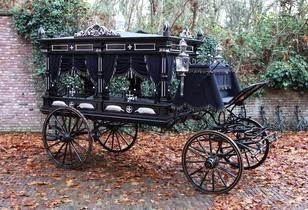
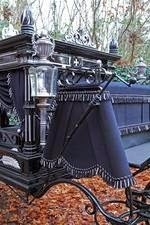
c.1905 Hearse
Coachwork by H. Topig Wagenbau, Leuba stritz, GermanyNo ReserveFOOTNOTESThe use of horse drawn hearses reached its peak in the early 1900's. European hearses tended to be more 'gothic' in design, often featuring heavily carved timber hammercloths, more elaborate head pieces along the upper edges of the body and seldom had glass side panels.
The hearse is finished in black throughout with silver leaf applied to the ornate carvings and lining detail. The hearse is fitted with patent collinge oil axles and runs on iron shod wheels.
The rear coffin here has been lined out with black wool cloth. The side openings feature black wool cloth swags and drapes that are edged with a silver and black bullion fringe. The here is accessed via a folding rear step and a hinged section of steel grating and is fitted with a runner mounted coffin plate.
Externally the solid timber hammer cloth and coachman's seat are upholstered in black wool cloth throughout. The coachman's toe board is fitted with a rubber mat. The roof features a decorated silver leaf urn that is fitted over a faux leather oil cloth covering. Original hearse lamps are fitted to the coachman's seat.
The hearse has been completely restored by Stolk of Holland and presents an ideal opportunity to purchase useful carriage for future use!
You'll find the complete catalogue for this auction online here.
Lot 203C.1800 SEDAN CHAIR£4,000 - 6,000
US$ 6,000 - 9,000


c.1800 Sedan Chair - No ReserveFOOTNOTES
Sedan chairs reached their peak across Europe in the late 1700's. They afforded a clean and safe means of transport to the nobility and upper middle classes. Many were kept inside houses where the owners could enter them before being carried out into the often, filthy streets. This sedan chair features a softwood frame construction with canvass stretched over for lightness. Externally the chair cabin is very original and would benefit from some conservation and stabilisation work. The panels depict cherubs and angels in differing scenes. The roof is leather covered, this is held in place with a carved moulding that has been picked out in gold leaf. Access to the cabin is via the front door that contains a single window, the side panels are also fitted with windows and all three can be lowered. Internally the cabin has been subject to an older restoration and is upholstered in a maroon velour material.A rare opportunity to acquire a sedan chair that would benefit from some conservation work.
Lot 205C.1880 PARK DRAGCoachwork by Holland & Holland, London, England£70,000 - 90,000
US$ 110,000 - 140,000



c.1880 Park Drag
Coachwork by Holland & Holland, London, EnglandFOOTNOTESHolland & Holland coachbuilders are widely regarded as building some of the finest light drags. Park Drags were used by gentlemen and ladies to attend race meetings and other events where they could be used to entertain friends and associates. Many were supplied with roof mounted picnic sets (imperials), sun shades and wine cellaretes that were contained within the rear boot.
This Park Drag is finished with a dark blue undercarriage, lower quarter panels and seat risers, the upper panels are black. The line detail is a deep red. It has been restored by Stolk of Holland and the Drag is representative of their high standard of craftsmanship. The Drag is fitted with patent mail oil axles and runs on English pattern iron shod wheels.
The passenger compartment is accessed on each side via door with a folding body step. The doors have a brass 'T' handle and there is a ivory plaque at the bottom of each door bearing the builders name. Internally the seat cushions and seat backs are upholstered in a blue wool cloth with blue tufted surface buttons and dark blue broad lace surrounds. The original oil cloth headlining has been preserved and brown leather hat straps are fitted. The window frames are finished in a blue wool cloth. Shutters are also contained within the door window recess, the nearside shutter is fitted with an internal mirror. The front internal seat back is hinged and lifting this gives access to the front boot that contains a comprehensive spares kit that includes a new set of brake shoes and supports for the roof mounted imperial. The rear boot contains correct type mahogany wine cellarets with zinc liners, with a top drawer for glasses/nappery
With the exception of minor cracks to the toe board and front boot the external coach painted mahogany panels are in very good condition. The external cushions are upholstered in blue wool cloth and the seat frames are bound in plain black leather. The roof seat lazy backs are hinged and give access to the roof mounted imperial (picnic set). With the top of the imperial removed the sides unfold to provide trays and a picnic platform. The foot platforms are covered with leather edged lino with protective pierced rubber over mats. The Coachman's toe board has a brass watch case mounted on it. A black wicker umbrella basket is fitted to the near side rear seat frame. The coachman's seat frame has a tan leather whip holder and tan leather passenger grab handles are fitted to all roof seats. Two spare bars are strapped to the rear of the grooms seat frame and a folding passenger ladder is hanging on the underside of the groom's seat. There is a coachman operated hand brake that acts on the rear wheels.
The Drag is complete with lamps (no makers name),a single lense toe board lamp team pole and bars and drag shoe. It represents a wonderful opportunity to compete at the highest level in the Coaching classes for many years to come.
Lot 210C.1890 HANSOM CABCoachwork by Forder & Co, London, England£20,000 - 25,000
US$ 30,000 - 38,000

c.1890 Hanson Cab
Coachwork by Forder & Co, London, EnglandNo ReserveFOOTNOTESDesigned to convey members of the public in safety and comfort Hansom cabs became a common site of the streets of London. Today Hansom Cabs are strongly associated with late Victorian crime writers and feature in many of the famous Sherlock Holmes books. Several companies built hansom cabs but it was the coachbuilders Forder & Co who developed the best known design of Cab and the award of several medals meant that they were favoured by cab proprietors. Designed to carry two passengers the driver sat high up on the rear mounted external seat.
This Hansom Cab is finished with a light green under carriage and a contrasting dark green line. The upper body panels have been conserved and are painted black. The cab is fitted with patent collinge oil axles and runs on rubber shod warner band type wheels.
The passenger compartment is accessed via double opening doors, these are operated by the driver who would pull the leather window strap thereby 'unlocking' the doors and allowing the passenger out, prior to payment of course!, which would have been made via the small roof hatch to the rear of the passenger compartment. The seat cushion and back are upholstered in a dark green wool cloth with matching broad lace edging. The remaining surface areas are also finished in a dark green wool cloth. The metal fittings in the compartment are silver plated and there is a builders plaque mounted on the rear seat back stating that the cab is 'Public Cab � Patent Number 2209 � Royal Hansom'. There are ivory surrounds attached to two side mirrors and a rare communication whistle is also fitted so that the driver could be alerted.
Externally the driver's seat is upholstered in a green wool cloth. The roof and upper panels have been conserved but they would have originally had a highly japanned finish. The dash board is covered in polished leather and the passenger boarding platform is fitted with a pyramid rubber mat. The cab would have been drawn by a single large horse and the shafts are ash with supporting ironwork. On the underside of each step there are extended supports that the cab would have rested on when not in use. Original correct type lamps are fitted to the Cab but they do not bear the builders name.
Lot 221C.1835 TRAVELING LANDAUCoachwork by Adams & Hooper, London, England£200,000 - 300,000
US$ 300,000 - 450,000

Ex-Royal British Mews, ex-James Coson Collection, Fastidiously Restored
c.1835 Traveling Landau
Coachwork by Adams & Hooper, London, EnglandFOOTNOTESThis outstanding carriage has been the subject of one of the most impressive restorations carried out in recent years.
Adams and Hooper were founded in 1805 and soon built up a reputation for building the finest carriages. From their premises in Haymarket, London, carriages were built for wealthy patrons the world over. By 1830 the company held the Royal Warrant.
Travelling Landaus were used by the nobility on extended tours throughout Britain and Europe. Designed to carry their owners in comfort over long distances they proved to be an ideal carriage prior to the introduction of the railways.
Ordered by the Royal Mews from Adams and Hooper for King William IV the Landau was delivered in 1835. The carriage would have been used by trusted representatives and possibly the King himself when undertaking long journeys. Other carriages and out riders would have formed part of the travelling entourage to carry luggage, servants and official documents. It is likely that the Landau was delivered with a detachable coachman's seat and hammer cloth, however over the course of time this has been lost. In its current configuration the Landau is arranged to by driven by postilion riders. It is uncertain why postilion riders came into being but one theory is that it allowed the occupants of the carriage to have 'open' conversations without fear of being overheard by the coachman. The Landau was sold by the Royal mews in the early part of the 20th Century. Following its sale from the Mews its history is uncertain but it was probably saved because of its 'Royal' history and provenance. Eventually it was acquired by the famous American collector James Coson and is featured in the book of his collection published in 1989, complete with a foreword from His Royal Highness Prince Philip. When the Coson collection was sold its new owner decided to restore the Landau to its original specification. The carriage was sent to the renowned restorers Stolk of Holland who over a period of time returned the Landau to its rightful former grandeur.
The Landau is resplendent in its Royal Colours of red under carriage with gold leaf lining and black flank detail, deep royal claret body panels with Royal crests and insignia and leather front and rear boots. Mounted on 'C' springs with leather braces the body has additional rope through braces allowing the carriage to cope with the roughest of roads. Strong grease axles are fitted and the Landau runs on iron shod English pattern wheels.
Access to the passenger compartment is made via double folding steps and doors from either side. A footman would have first lowered the windows or shutter, opened the door and then unfolded the carpeted steps, once safely inside the footman would have folded the steps back into position and then closed the door making sure that the glass strings were not caught in the step recess. Inside the carriage the seat cushions and back are upholstered in a deep blue brocade with surface buttoning. The doors, seat falls and hood linings are finished in a dark blue wool cloth, and beautifully woven bespoke 3 inch broad laces are used to edge the cushions, door surrounds and glass strings. Each door contains a blue wool cloth trimmed window and separate shutter with a brass makers name plate. The louvres for each shutter can be adjusted by a small brass ratchet set into the varnished frame. The individual shutters are finished in red with a broad gold leaf line with fine black flank lines.
Externally the Landau has been beautifully coach painted, period coach painting books often describe the finished panels of carriages as having a 'glass like depth' to them and ground pumice would have been used to polish out small particles of dust. The panels on the Landau are a true reflection of the finish achieved by the very best coach painters some 150 years ago. The lower claret body panels and doors feature hand painted royal coats of arms and insignia detail. Each will have been painted directly onto the panel by hand and will have taken several hundred hours to complete; they have then been varnished over for protection. To the front of the carriage there is a leather covered 'Salisbury boot' adorned with four brass crowns, access is via the front hinged lid and it would have been used to store spares for the coach and harness when travelling
Beautifully detailed lamps are attached directly to the front folding hood, they have been silver plated internally and have a small royal crown on each candle font, larger brass crowns sit atop each lamp.
The folding leather hoods are held in position by black hood jacks and three brass royal insignias are fitted along the top edge of each hood side panel. The leather hood covering has been hand stitched into position, the raw leather seams have been 'plain bound' in the correct fashion and the whole structure is fastened in position with brass pin bead. To the rear of the main body there is a leather covered 'sword case', gentlemen travelling in the Landau would have been expected to remove their swords and to have placed them within the 'sword case' which is accessed via a hinged rear seat back panel.
At the back of the Landau there is a leather covered Rumble seat where two footmen would have sat, the seat is mounted on leaf springs to give some comfort during long journeys and is upholstered in a dark blue wool cloth. The area underneath the seat provides additional storage and is accessed via the hinged rear flap.
The under carriage is finished in red with gold leaf detail, on each corner there is a large 'C' spring. Hand stitched leather braces run around the outside of each spring to support the body, the height of which is adjusted on large ratchet adjusters. Additional leather covered rope bracing runs the length of the Landau to control the front to back movement of the body, whilst on the underside of the body there are two further leather straps that control the side to side 'sway'.
Hanging from the perch there are three separate devices to control the Landau when descending or ascending hills and stopping. The first is a drag shoe that would have been used as a skid to lock up the rear nearside wheel when descending a hill. The second is the small hinged red pole, called a drag staff, that would have been lowered onto the ground when ascending a hill, if the Landau had to stop for any reason the pole would have dug into the road surface to stop the carriage from rolling back. The last item is the leather covered hook, this would have been used as a parking brake with the hook placed around a wheel spoke.
The Landau is a truly wonderful piece of early Royal transport and the restoration work carried out to return it to its former glory is unlikely to be ever repeated again.
Lot 228C.1905 HEARSECoachwork by H. Topig Wagenbau, Leuba stritz, Germany£5,000 - 8,000
US$ 7,500 - 12,000


c.1905 Hearse
Coachwork by H. Topig Wagenbau, Leuba stritz, GermanyNo ReserveFOOTNOTESThe use of horse drawn hearses reached its peak in the early 1900's. European hearses tended to be more 'gothic' in design, often featuring heavily carved timber hammercloths, more elaborate head pieces along the upper edges of the body and seldom had glass side panels.
The hearse is finished in black throughout with silver leaf applied to the ornate carvings and lining detail. The hearse is fitted with patent collinge oil axles and runs on iron shod wheels.
The rear coffin here has been lined out with black wool cloth. The side openings feature black wool cloth swags and drapes that are edged with a silver and black bullion fringe. The here is accessed via a folding rear step and a hinged section of steel grating and is fitted with a runner mounted coffin plate.
Externally the solid timber hammer cloth and coachman's seat are upholstered in black wool cloth throughout. The coachman's toe board is fitted with a rubber mat. The roof features a decorated silver leaf urn that is fitted over a faux leather oil cloth covering. Original hearse lamps are fitted to the coachman's seat.
The hearse has been completely restored by Stolk of Holland and presents an ideal opportunity to purchase useful carriage for future use!
You'll find the complete catalogue for this auction online here.
Published on February 15, 2015 23:30
February 12, 2015
LOOSE IN LONDON: ROYAL DAY OUT, PART ONE
Beginning a memorable day (for several reasons, LOL) on Tuesday, September 2, 2014...our pre-ordered ticket for the Extravaganza known as the Royal Day Out! Victoria here (eventually telling MY side of the story), beginning with our delicious breakfast at our hotel's adjacent restaurant...
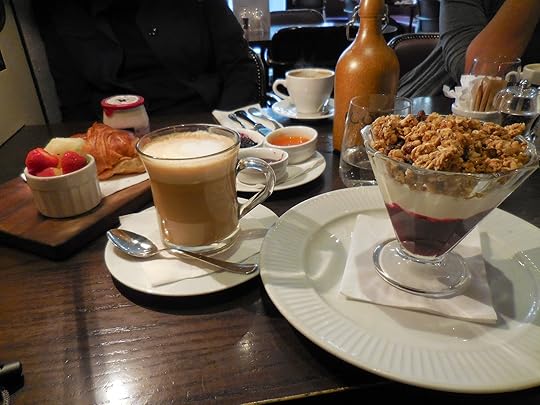 Yum!
Yum!The day's activities were scheduled to begin at the Royal Mews, continue through the Queen;s Gallery and be crowned by the tour of Buckingham Palace. What could be better? To be accompanied on this lovely day by three delightful companions -- Kristine, Diane Gaston and Marilyn Gaston (sisters) with whom to share every experience....but again, more about that later!
It was not the first visit to the Royal Mews for three of our quartet. As a matter of fact, for me, it was the fourth visit, but since I love horses and the fragrance of a stable always makes me think of happy times (and not an odoriferous dump) I never pass up a chance to go back.
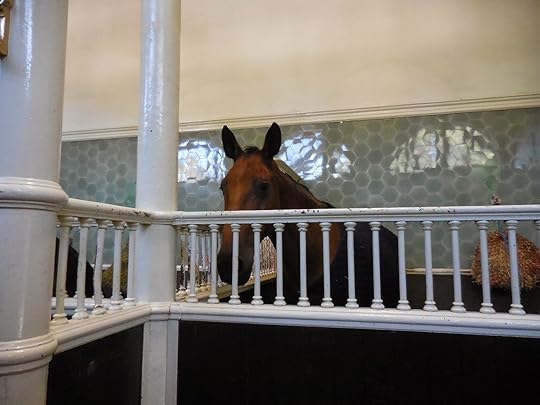
As you can see, it is kept spotlessly clean, but horses will be horses, and even in this exalted spot, their evidence takes a few minutes to remove...thus one of my childhood memories is readily triggered.
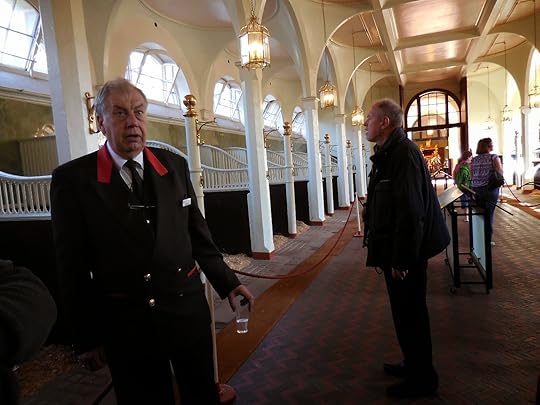 Our guide was a veteran of many years in the Queen's service and shared wonderful reminiscences. I hope I have the correct names for the coaches below.
Our guide was a veteran of many years in the Queen's service and shared wonderful reminiscences. I hope I have the correct names for the coaches below. 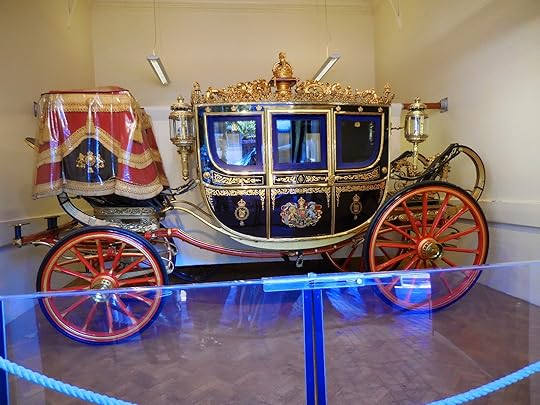 Irish State Coach
Irish State CoachThe carriages are superbly maintained and displayed.
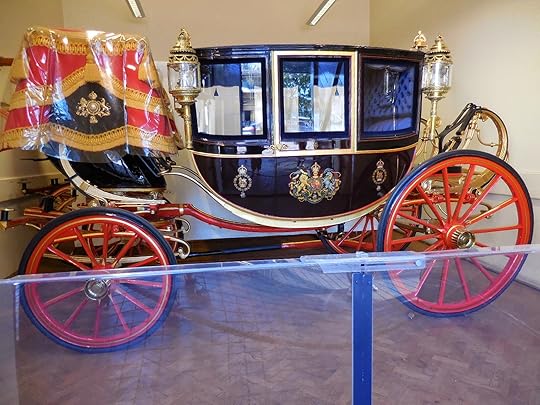 The Glass Coach
The Glass Coach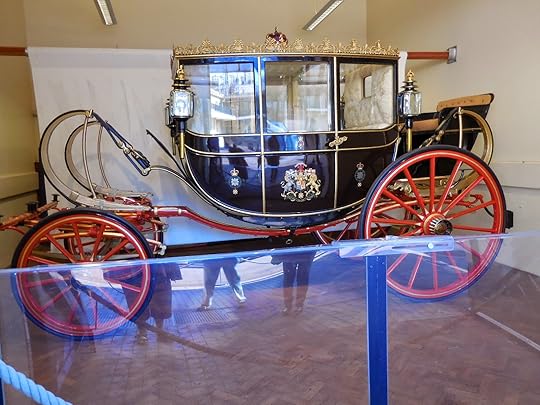 The Scottish State Coach
The Scottish State Coach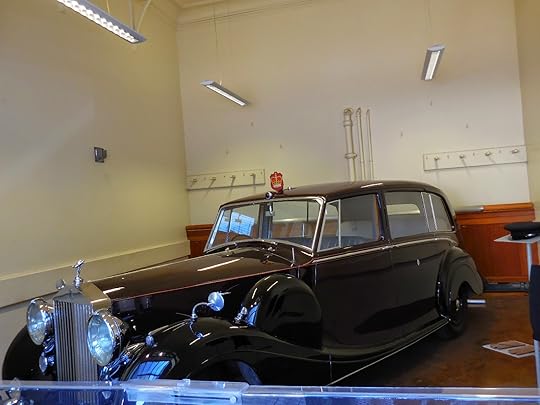 A Rolls Royce Phantom IV is tucked off in a corner, perhaps useful for a run to the supermarket.
A Rolls Royce Phantom IV is tucked off in a corner, perhaps useful for a run to the supermarket.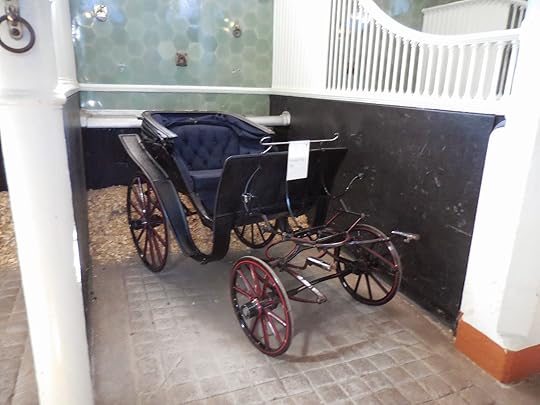 Pony Cart
Pony Cart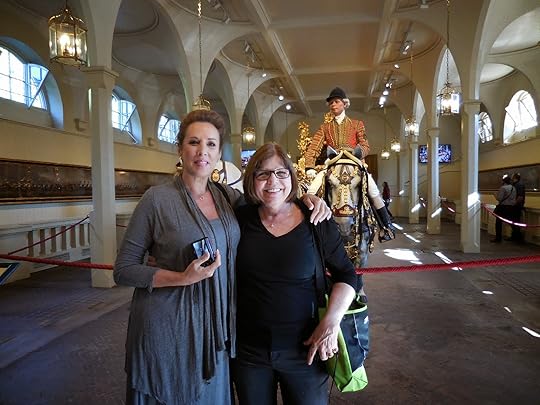 Kristine and Diane pose in front of the oncoming coach; luckily, the horses and postilion are only models or the girls would have been trampled.
Kristine and Diane pose in front of the oncoming coach; luckily, the horses and postilion are only models or the girls would have been trampled.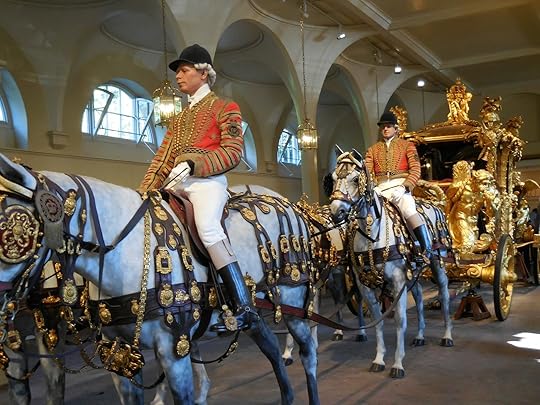
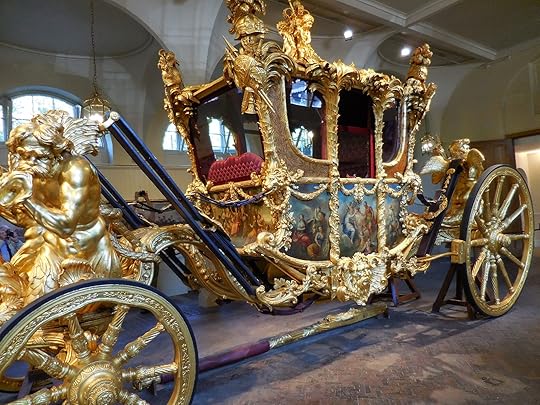 The Gold State Coach, completed in 1762
The Gold State Coach, completed in 1762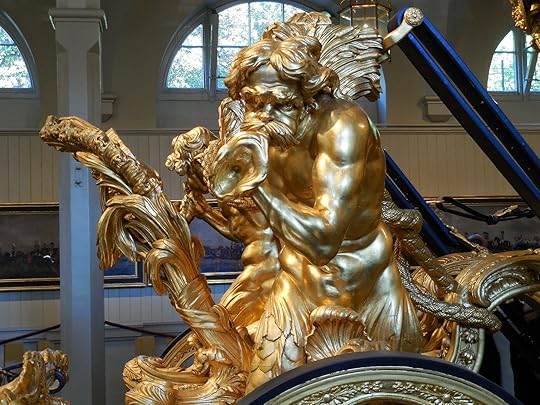 A Triton blowing his conch shell horn to announce the approaching monarch; the carvings were executed by sculptor Joseph Wilton.
A Triton blowing his conch shell horn to announce the approaching monarch; the carvings were executed by sculptor Joseph Wilton.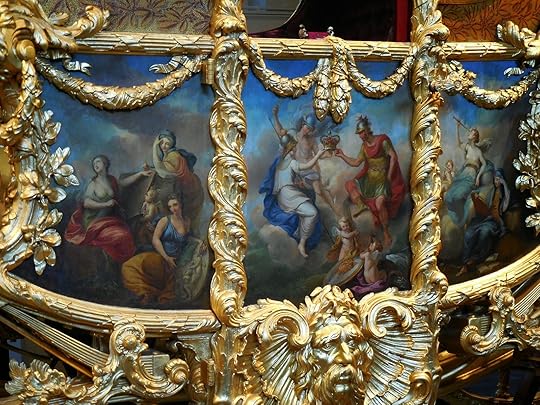 The panel paintings are Giovanni Cipriani, an Italian living in London
The panel paintings are Giovanni Cipriani, an Italian living in London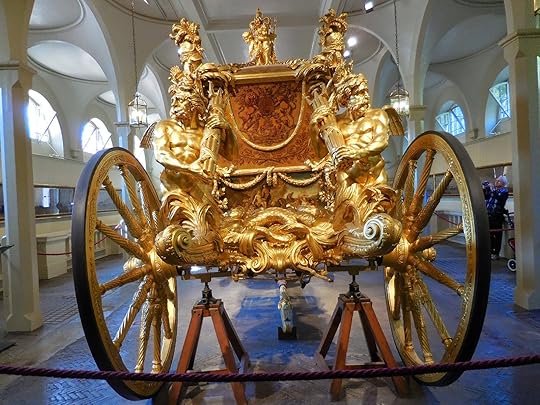 From the Rear
From the RearThis concludes Part One of the Royal Day Out, So far, so good, group-wise...the crunch was yet to come. I should add that we spent quite a bit of time in the gift shop, but in view of our upcoming time at the Queen's Gallery and in the Palace, we saved our actual purchases for later.
More Loose In London Coming Soon!
Published on February 12, 2015 23:37
February 11, 2015
STAYING POWER: PHOTOGRAPHS OF BLACK BRITISH EXPERIENCE 1950s to 1990s

Staying Power: Photographs of Black British Experience 1950s-1990s 16 February – 24 May 2015 vam.ac.uk/page/s/staying-power/
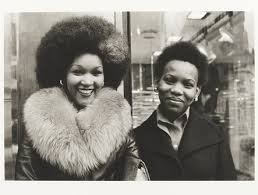 High Street Kensington, 1976, © Al Vandenberg
High Street Kensington, 1976, © Al VandenbergThis spring the V&A will present a display of over 50 recently acquired photographs that explore the experiences of black people in Britain in the latter half of the 20th century, enhanced by excerpts from oral histories gathered by Black Cultural Archives. Over the last seven years the V&A has been working with Black Cultural Archives to acquire photographs either by black photographers or which document the lives of black people in Britain, a previously under-represented area in the V&A’s photographs collection. Funded by the Heritage Lottery Fund (HLF), the Museum has been able to collect 118 works by 17 artists ranging from Yinka Shonibare’s large-scale series Diary of a Victorian Dandy (1998), to studies of elaborate headties worn by Nigerian women, by J.D. Okhai Ojeikere, to black and white street photography of 1970s London by Al Vandenberg.
Staying Power will showcase a variety of photographic responses to black British experience. On display will be intimate portrayals of British-Caribbean life in London in the 1960s-70s by Neil Kenlock, Armet Francis, Dennis Morris and Charlie Phillips. Music, style and fashion are documented in Raphael Albert’s depictions of the black beauty pageants he organised from the 1960s to the 1980s to help celebrate the growing black community in Britain and Norman ‘Normski’ Anderson’s colourful depictions of vibrant youth culture of the 1980s and 90s.
The display also features more conceptual explorations of race and identity. Yinka Shonibare’s series, Diary of a Victorian Dandy, depicts the artist playing the role of a dandy. The work demonstrates Shonibare’s identification with the dandy as an outsider or foreigner who uses his flamboyance, wit and style to penetrate the highest levels of society, which would otherwise be closed to him. Maxine Walker also draws attention to racial stereotypes by photographing herself in a variety of guises. In her Untitled series (1995) she presents herself with different skin tones and hairstyles as though they were instantaneous transformations made in a photo booth.
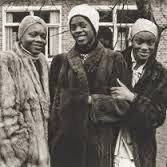
The V&A’s Photographs Collection - The V&A was the first museum to collect and exhibit photography as an art form. It now holds the UK's national collection of art photography, which is one of the largest and most important in the world. The V&A has over 500,000 photographs in its collections, ranging from works created in 1839, when the medium was first invented, to the present.
Black Cultural Archives - Founded in 1981, Black Cultural Archives’ mission is to collect, preserve and celebrate the heritage and history of Black people in Britain. They opened the UK’s first dedicated Black heritage centre in Brixton, London in July 2014, enabling greater access to the archive collection and providing dedicated learning spaces and an exciting programme of exhibitions and events that explore British history from a unique perspective. The archive collection offers insight into the history of people of African and Caribbean descent in Britain and includes personal papers, organisational records, rare books, ephemera, photographs, and a small collection of objects. bcaheritage.org.uk
Published on February 11, 2015 00:00
February 8, 2015
LOOSE IN LONDON: DOING THE CHIMP WALK
Many of you have commented on the amount of things Victoria and I seem to cram into each and every day whenever we're in London. It's true - we're on a mission, we're only there for a period of time and we want to see and experience all that we can. More often than not, we forget that we're only human (and of a certain age) and so we push ourselves,expecting our bodies to respond to all we ask of it and expecting no unwanted consequences in return. Boy, are we surprised when, by the end of a busy day, we become aware of our bodies balking at the onslaught and teaching us a lesson by making us aware of aches, pains and diminished energy. Our feet, naturally, become the biggest complainers. Slowly, over the course of a day, the toll on our bodies becomes evident, especially in the way we walk.
Having a distinctive walk of one's own is not always a bad thing. After all, there have been many famous walks through history - there's the Cake Walk of the 1940's
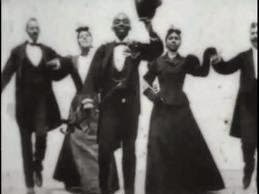
watch the video here
The Camel Walk
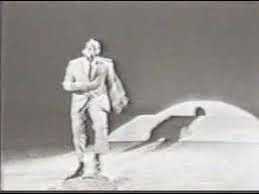
watch video here
The Crip Walk

watch video here
And of course the Moon Walk
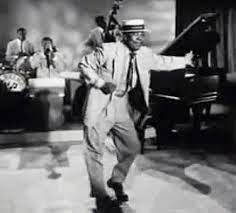
Watch it here
Unfortunately, the walk Victoria and tend to develop by day's end is not quite so pretty. It's a gait that comes from sore backs, aching hips and, the biggest culprit, sore feet. All those elements combine to have a strange effect on our gait at the end of a London sightseeing day. You can watch it here. Yes, dear Reader, Victoria and I are now officially The Chimp Sisters, at least when we're in England.
Published on February 08, 2015 23:30
Kristine Hughes's Blog
- Kristine Hughes's profile
- 6 followers
Kristine Hughes isn't a Goodreads Author
(yet),
but they
do have a blog,
so here are some recent posts imported from
their feed.



